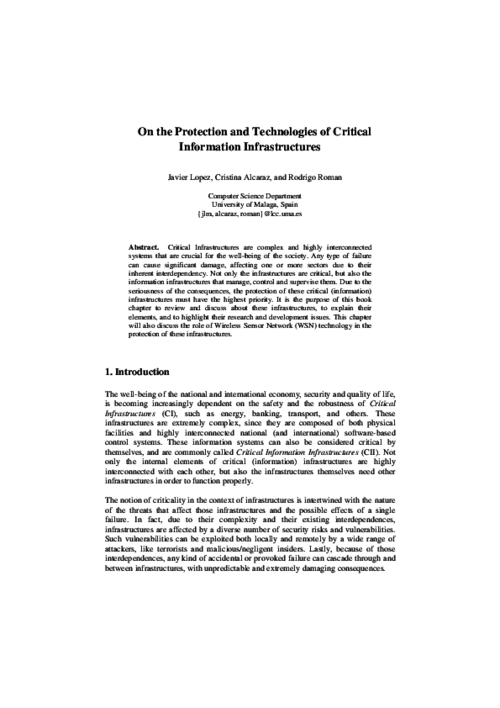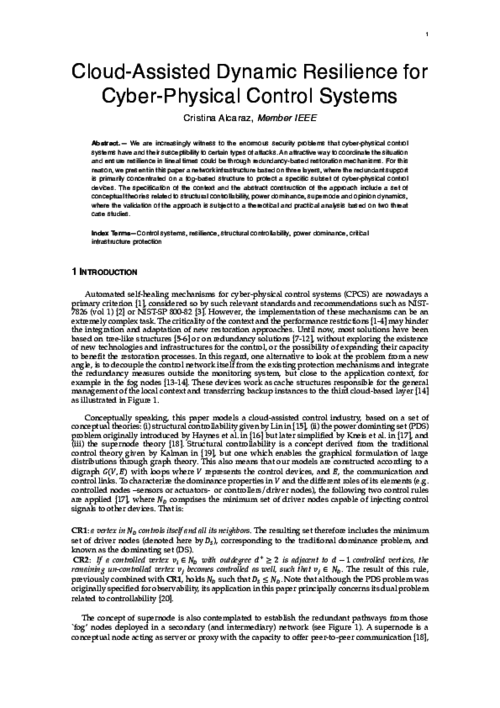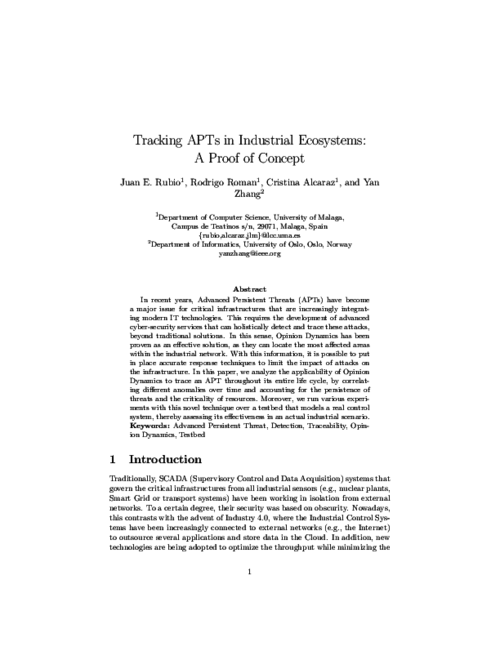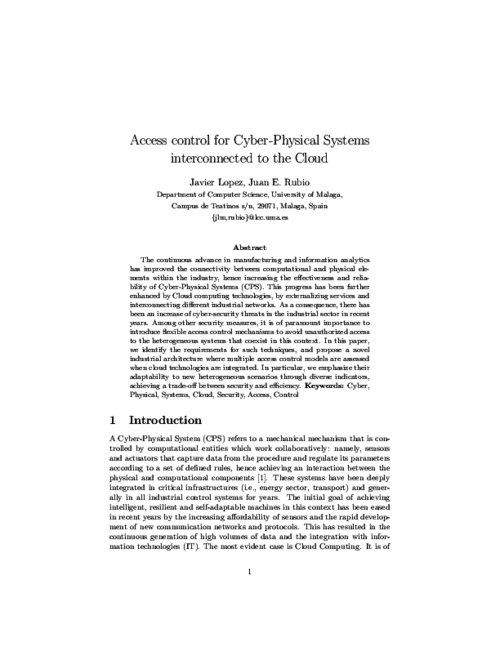Critical Infrastructures Protection
Critical (Information) Infrastructures Protection (CIIP/CIP) is becoming one of the most cutting-edge research areas over the last few years. Private and public entities are joining efforts to offer attractive solutions so as to face threatening situations that can alter the business continuity of a system and the deliberation of essential services to end-users (citizens, industries, governments, etc.). However, this is not a trivial task since these types of systems are everytime more dependent on Information Technologies (ITs) for the management of services and critical information. This type of dependence requires that topics related to security and protection are considered in which situational awareness, prevention [1][2] and response [3] should become priority aspects [4], especially against Advanced and Persistent Threats (APTs). Namely, any fault, anomaly, and physical or cyber attack might put the operational performance, security and safety of a system at risk, and the effect may propagate by itself towards other critical infrastructures with high probability of impacting on basic services due to the existing interdependence relationships.
Industry 4.0, IIoT and CPS
The advent of Industry 4.0 [5], also known as the fourth industrial revolution, aims to establish the ways to boost and converge IT networks with operational technologies (OT) [6] such as sensors, actuators and controllers, in order to create profitable and autonomous environments with the capacity to improve the value chain, production costs and competence (see Fig. 1). Particularly, the paradigm constitutes a technological complex scenario where new and legacy devices have to coexist for sharing resources and data [7][8][9], probably with connection to infrastructures such as Cloud/Fog Computing for data processing and storage [10][11]. This way of de-centralising resources allows underlying infrastructures to efficiently manage operations in the plant/field, digitalise processes and provide "smart" solutions in real-time. Unfortunately, many security issues arise [12] due to the implicit heteogeniety and complexity of the context itself.
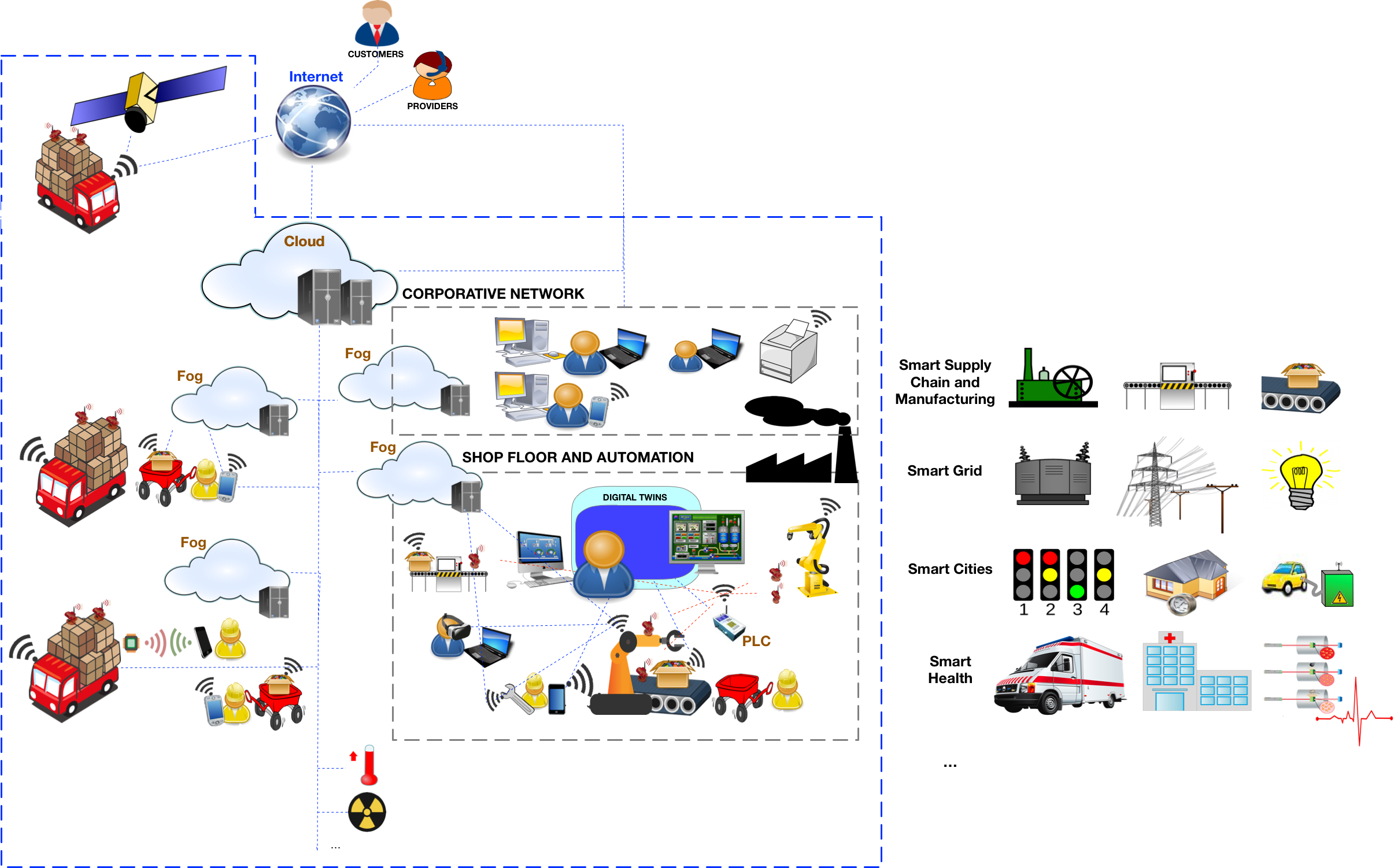
Fig. 1: Industry 4.0 and application environments
Within Industry 4.0, NICS Lab presents wide expertise in the application areas of supply chain (CyberSec4Europe, SADCIP, SADECEI-4.0, DISS-IIoT), energy (SealedGRID, CAIN, PERSIST, TIGRIS, SECRET, PROTECT-IC), water (FACIES) and healthcare (CYBSEC-TECH). Most of them focus on topics related to wide-area situational awareness [13][14] against stealthy [15][16] and APT attacks [17][18][19][20] (the latter includes practical results at I4Testbed) and secure interconnection of critical systems [6][21][8][22][23][24], in addition to consider human intervention in these types of so critical facilities [25]. Apart from the referenced projects, we also have extensive experience in the protection of cyber-physical monitoring systems such as SCADA (Supervisory Control and Data Acquisition) ones, working on several related R&D projects such as PISCIS, ATENEA and CRISIS, among others.
In the supply chain field, we have been involved in the dynamic detection of APTs making use of theoretical models such as Opinion Dynamics to prevent the influence of advanced threats in real time [17]. Opinion Dynamics allows a system to detect anomaly states in widely complex and heterogenous networks, providing (local and global) health indicators, traceability mechanisms [18] and dependability (through QoS) in the industrial networks [26]. As a result of this study, several network traffic captures in Modbus/TCP can be downloaded from the I4Testbed website of NISC Lab., which includes some traffic traces (considering normal and perturbed traffic) and graphics that show the effectiveness of the approach for IT-OT environments. Presently, and through the project SADECEI-4.0, NICS Lab is involved in the new industrial virtualization paradigm known as Digital Twin. The aim is to virtualize the entire situational awareness process (as part of the WASA framework defined in [14]) in a much more specific environment in which human operators and the system itslef are able to evaluate and trace any situation in time. To achieve this, underlying technologies to the Digital Twins, such as software agents leading distributed consensus algorithms (e.g., Opinion Dynamics or other related ones), blockchain and machine learning/data mining are also considered.
We have also modelled multiple CPS/IIoT-based protection approaches for particular energy subdomains of a Smart Grid, and have analysed communication protocols such as Modbus/TCP [15], OCPP [27][28], ZigBee PRO, ISA100.11a and WirelessHART [29]. Throughout all these research activities and projects, we have not only learned new vulnerabilities and cyber-attacks associated with energy control substations, but also vulnerabilities and threats associated with smart meters, which may corrupt users' privacy [30][31][32][33][34] (this latter also explores other interconnection issues related to federated SealedGRID networks). In order to model complex CPSs for power neworks and show the control relationship between their elements, aspects associated with structural controllability have also been considered. We first studied the structural weaknesses of the control networks through the specification and implementation of multiple types of perturbations [35][36] to later explore recovery [10][37][38][7][39][22] and prediction solutions [40] for resilience. As for water treatment control systems and in the FACIES context, NICS Lab has also been involved in prevention issues against stealth attacks [14] and in the study of methodologies for anomaly-based intrusion detection [41] and automatic response [3]. In order to reinforce the research, several analysis about the implications of machine-learning in prevention and detection techniques have also been provided in [42][43].
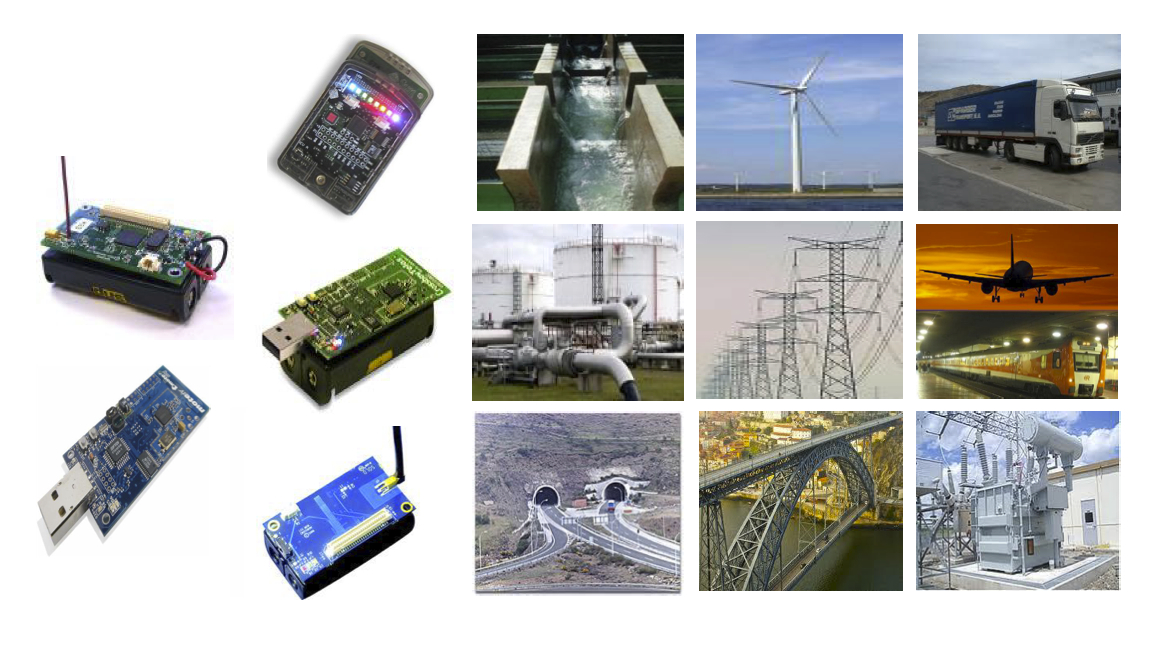
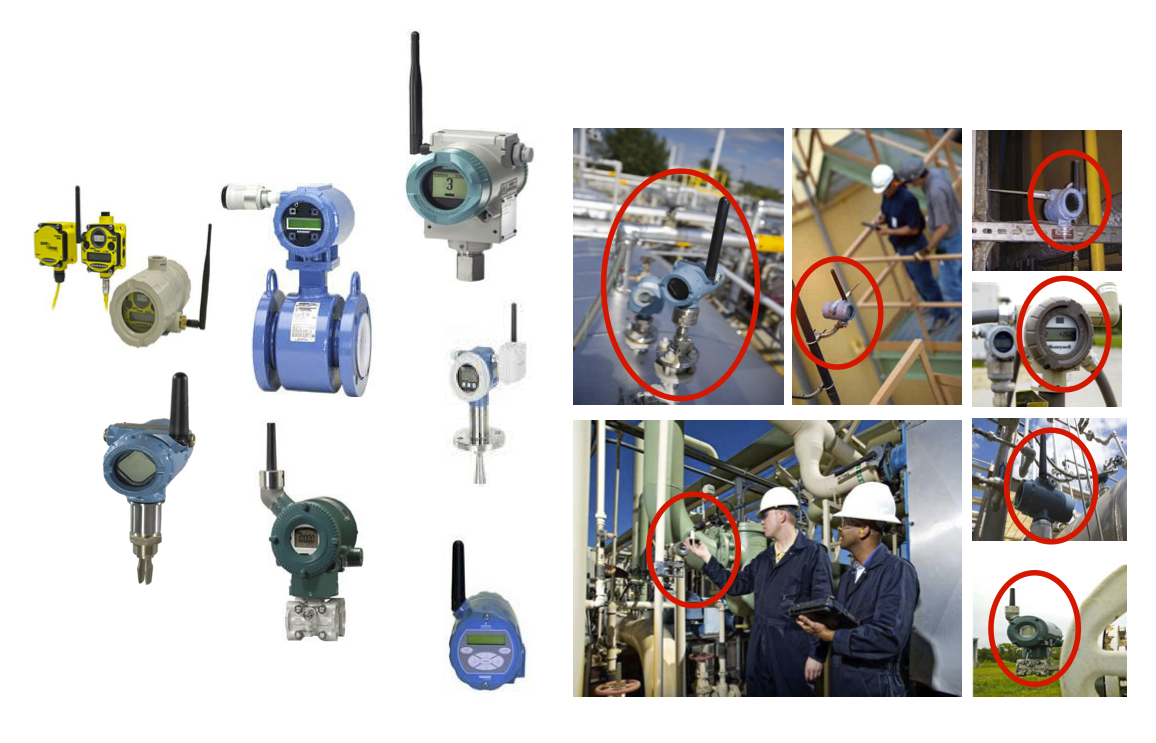
Fig. 2: IoT and IIoT devices suitable for industrial environments
Secure traditional monitoring systems
Tradittionally, we have witnessed the new advances in the CPS field and the technological evolution of the traditional monitoring systems [44][45][46], which are still exposed to multiple vulnerabilities. Many of these vulnerabilities are due to the IT-OT technological convergence and their connection to the Internet, while others are due to the inefficient use of the security policies and perimetral protection measures. Security systems (e.g., firewalls or intrusion detection systems) are normaly based on inaccurate rules/patterns, interoperability issues and conflicts, abuse and use of weak security credentials based on username-password with high visibility and low update using insecure cryptosystems, vulnerable TCP/IP-based protocols, implementation bugs, non-segregation of functions, interferences or industrial noise, strong dependence on third-parties’ components, and so on [47][45][44]. The beginning of this research relies on the work led in the projects CRISIS, ATENEA, PROTECT-IC and eCID, which have allowed us to understand the main vulnerabilities of the SCADA systems and adapt control alternatives (e.g., wireless sensor networks (WSNs) - see Fig. 2) for the 24/7 monitoring of control substations [48] without hampering with the minimal control requirements [49]. Today, many of the new alternatives not only aim at a local monitoring, but also to a remote monitoring. This means that it is necessary to study the TCP/IP connection benefits and drawbacks when traditional control devices (e.g., PLCs/RTUs) need to connect by themselves to centralised SCADA systems [48]. In this regards, it is vital to assess whether these elements as part of IoT/IIoT [48][50][51] are able to keep a suitable tradeoff between security and operational performance, and its viability for any critical scenario. In this sense, a risk management methodology has been specified in [52] to explore the role of IoT/IIoT and CPS technologies (also assessed in [53][54] but only for WSNs) in the diverse critical infrastructures (aircraft, SCADA systems, healthcare, etc.) and the cost that can cause a realistic cyber-attack (e.g., of the type of Stuxnet) in such technologies and environments.
References
-
"An Early Warning System based on Reputation for Energy Control Systems",
IEEE Transactions on Smart Grid, vol. 2, no. 4, IEEE, pp. 827-834, Nov 2011. DOI
 More..
More..Abstract
Most of energy control or SCADA (Supervisory Control and Data Acquisition) systems are very dependent on advanced technologies and on traditional security mechanisms for protecting the a system against anomalous events. Security mechanisms are not enough to be used in critical systems, since they can only detect anomalous events occurring at a certain moment in time. For this reason it becomes of paramount importance the usage of intelligent systems with capability for preventing anomalous situations and reacting against them on time. This type of systems are, for example, Early Warning Systems (EWS). In this paper, we propose an EWS based on Wireless Sensor Networks (WSNs) (under the ISA100.11a standard) and reputation for controling the network behaviour. The WSN are organized into clusters where a Cluster Head (CH) is designated. This CH will contain a Reputation Manager Module. The usability of this approach is also analyzed considering a Smart Grid scenario.} keywords = {Critical Information Infrastructures, Sensor Networks, Early Warning Systems, Reputation, SCADA Systems, Smart Grid.
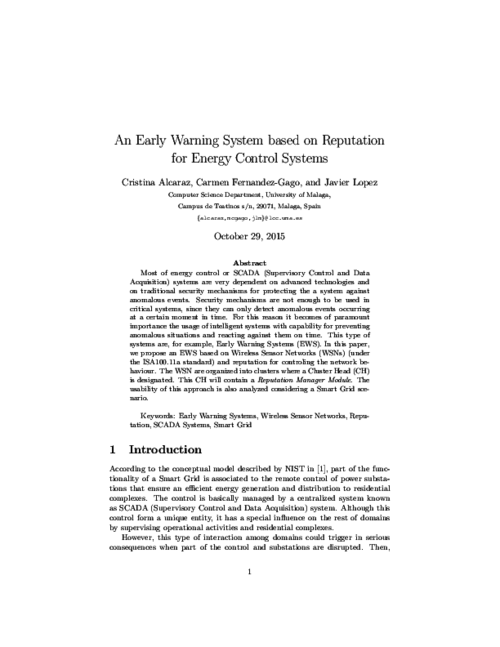
-
"Early Warning System for Cascading Effect Control in Energy Control Systems",
5th International conference on Critical Information Infrastructures Security (CRITIS’10), LNCS 6712, Springer, pp. 55-67, September, 2010.
 More..
More..Abstract
A way of controlling a cascading effect caused by a failure or a threat in a critical system is using intelligent mechanisms capable of predicting anomalous behaviours and also capable of reacting against them in advance. These mechanisms are known as Early Warning Systems (EWS) and this will be precisely the main topic of this paper. Specially, we present an EWS design based on a Wireless Sensor Network (using the ISA100.11a standard) that constantly supervise the application context. This EWS is also based on forensic techniques to provide dynamic learning capacities. As a result, this new approach will aid to provide a reliable control of incidences by offering a dynamic alarm management, identification of the most suitable field operator to attend an alarm, reporting of causes and responsible operators, and learning from new anomalous situations.
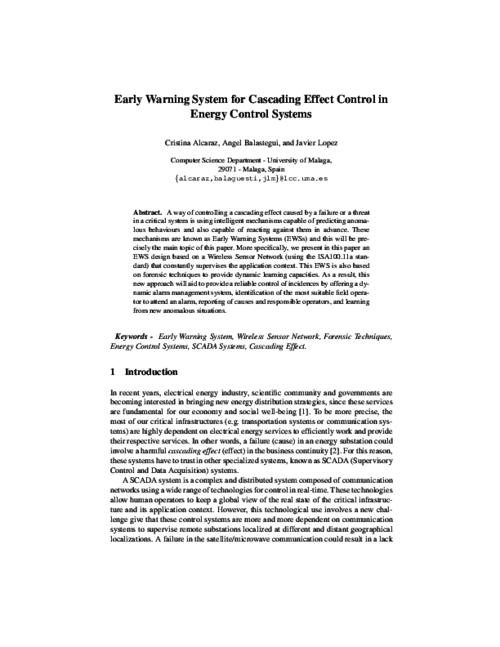
-
"Awareness and Reaction Strategies for Critical Infrastructure Protection",
Computers and Electrical Engineering, vol. 47, issue October, Elsevier, pp. 299-317, 2015. DOI
 (I.F.: 1.084)More..
(I.F.: 1.084)More..Abstract
Current Critical Infrastructures (CIs) need intelligent automatic active reaction mechanisms to protect their critical processes against cyber attacks or system anomalies, and avoid the disruptive consequences of cascading failures between interdependent and interconnected systems. In this paper we study the Intrusion Detection, Prevention and Response Systems (IDPRS) that can offer this type of protection mechanisms, their constituting elements and their applicability to critical contexts. We design a methodological framework determining the essential elements present in the IDPRS, while evaluating each of their sub-components in terms of adequacy for critical contexts. We review the different types of active and passive countermeasures available, categorizing them and assessing whether or not they are suitable for Critical Infrastructure Protection (CIP). Through our study we look at different reaction systems and learn from them how to better create IDPRS solutions for CIP.
Impact Factor: 1.084Journal Citation Reports® Science Edition (Thomson Reuters, 2015)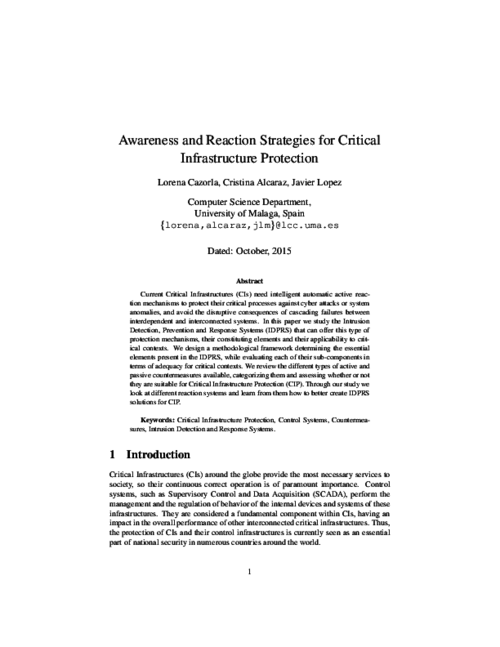
-
"PDR: A Prevention, Detection and Response Mechanism for Anomalies in Energy Control Systems",
7th International Conference on Critical Information Infrastructures Security (CRITIS 2012), vol. 7722, pp. 22–33, 2013.
 More..
More..Abstract
Prevention, detection and response are nowadays considered to be three priority topics for protecting critical infrastructures, such as energy control systems. Despite attempts to address these current issues, there is still a particular lack of investigation in these areas, and in particular in dynamic and automatic proactive solutions. In this paper we propose a mechanism, which is called PDR, with the capability of anticipating anomalies, detecting anomalous behaviours and responding to them in a timely manner. PDR is based on a conglomeration of technologies and on a set of essential components with the purpose of offering situational awareness irrespective of where the system is located. In addition, the mechanism can also compute its functional capacities by evaluating its efficacy and precision in the prediction and detection of disturbances. With this, the entire system is able to know the real reliability of its services and its activity in remote substations at all times.
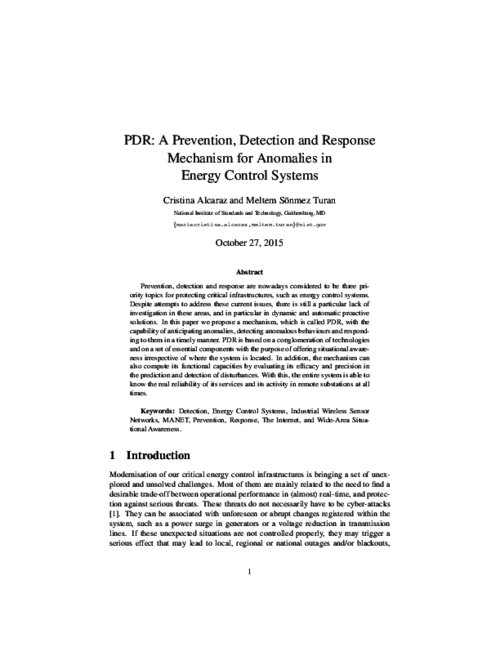
-
"Protecting Industry 4.0 against Advanced Persistent Threats",
European CIIP Newsletter, vol. 11, issue 26, no. 1, European CIIP Newsletter, pp. 27-29, 03/2017.
 More..
More..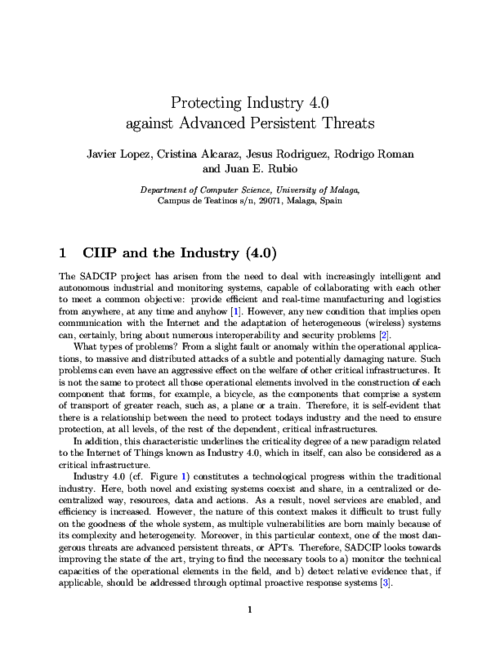
-
"Secure Interconnection of IT-OT Networks in Industry 4.0",
Critical Infrastructure Security and Resilience: Theories, Methods, Tools and Technologies, no. Advanced Sciences and Technologies for Security Applications book series (ASTSA), Springer International Publishing, pp. 201-217, 01/2019. DOI
 More..
More..Abstract
Increasingly, the society is witnessing how today’s industry is adapting the new technologies and communication protocols to offer more optimal and reliable services to end-users, with support for inter-domain communication belonging to diverse critical infrastructures. As a consequence of this technological revolution, interconnection mechanisms are required to offer transparency in the connections and protection in the different application domains, without this implying a significant degradation of the control requirements. Therefore, this book chapter presents a reference architecture for the new Industry 4.0 where the interconnection core is mainly concentrated in the Policy Decision Points (PDP), which can be deployed in high volume data processing and storage technologies such as cloud and fog servers. Each PDP authorizes actions in the field/plant according to a set of factors (entities, context and risks) computed through the existing access control measures, such as RBAC+ABAC+Risk-BAC (Role/Attribute/Risk-Based Access Control, respectively), to establish coordinated and constrained accesses in extreme situations. Part of these actions also includes proactive risk assessment measures to respond to anomalies or intrusive threats in time.

-
"A Cyber-Physical Systems-Based Checkpoint Model for Structural Controllability",
IEEE Systems Journal, vol. 12, issue 4, IEEE, pp. 3543-3554, 12/2018. DOI
 (I.F.: 4.463)More..
(I.F.: 4.463)More..Abstract
The protection of critical user-centric applications, such as Smart Grids and their monitoring systems, has become one of the most cutting-edge research areas in recent years. The dynamic complexity of their cyber-physical systems (CPSs) and their strong inter-dependencies with power systems, are bringing about a significant increase in security problems that may be exploited by attackers. These security holes may, for example, trigger the disintegration of the structural controllability properties due to the problem of non-locality, affecting, sooner or later, the provision of the essential services to end-users. One way to address these situations could be through automatic checkpoints in charge of inspecting the healthy status of the control network and its critical nature. This inspection can be subject to special mechanisms composed of trustworthy cyberphysical elements capable of detecting structural changes in the control and activating restoration procedures with support for warning. This is precisely the aim of this paper, which presents a CPSs-based checkpoint model with the capacity to manage heterogeneous replications that help ensure data redundancy, thereby guaranteeing the validity of the checkpoints. As a support to this study, a theoretical and practical analysis is addressed to show the functionality of the approach in real contexts.
Impact Factor: 4.463Journal Citation Reports® Science Edition (Thomson Reuters, 2018)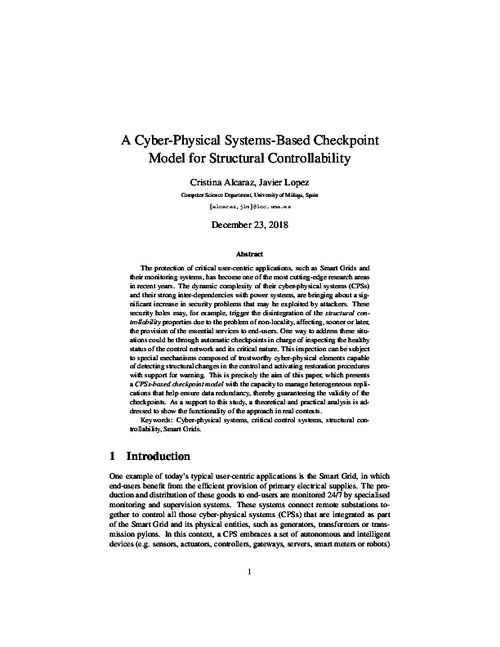
-
"WASAM: A Dynamic Wide-Area Situational Awareness Model for Critical Domains in Smart Grids",
Future Generation Computer Systems, vol. 30, Elsevier, pp. 146-154, 2014. DOI
 (I.F.: 2.786)More..
(I.F.: 2.786)More..Abstract
Control from anywhere and at anytime is nowadays a matter of paramount importance in critical systems. This is the case of the Smart Grid and its domains which should be monitored through intelligent and dynamic mechanisms able to anticipate, detect and respond before disruptions arise within the system. Given this fact and its importance for social welfare and the economy, a model for wide-area situational awareness is proposed in this paper. The model is based on a set of current technologies such as the wireless sensor networks, the ISA100.11a standard and cloud-computing together with a set of high-level functional services. These services include global and local support for prevention through a simple forecast scheme, detection of anomalies in the observation tasks, response to incidents, tests of accuracy and maintenance, as well as recovery of states and control in crisis situations.
Impact Factor: 2.786Journal Citation Reports® Science Edition (Thomson Reuters, 2014)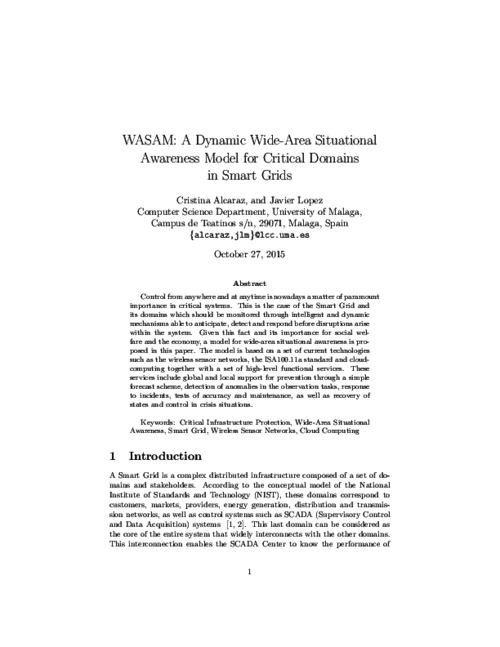
-
"Diagnosis Mechanism for Accurate Monitoring in Critical Infrastructure Protection",
Computer Standards & Interfaces, vol. 36, issue 3, Elsevier, pp. 501-512, 2014. DOI
 (I.F.: 0.879)More..
(I.F.: 0.879)More..Abstract
Situational awareness for critical infrastructure protection, such as for energy control systems, has become a topic of interest in recent years. Despite attempts to address this area of research, more progress is still necessary to find attractive solutions that help bring about prevention and response at all times from anywhere and at any time. Given this need, we therefore propose in this paper, a smart mechanism able to offer a wide-area situational awareness with the ability to: (i) Control the real state of the observed infrastructure, (ii) respond to emergency situations and (iii) assess the degree of ccuracy of the entire control system. To address these aspects, the mechanism is based on a hierarchical configuration of industrial sensors for control, the ISA100.11a standard for the prioritization and alarm management, and the F-Measure technique to study the level of accuracy of a sensor inside a neighbourhood. As proof of the functionality and feasibility of the mechanism for critical contexts, a software application implemented in nesC and Java is also presented in this paper.
Impact Factor: 0.879Journal Citation Reports® Science Edition (Thomson Reuters, 2014)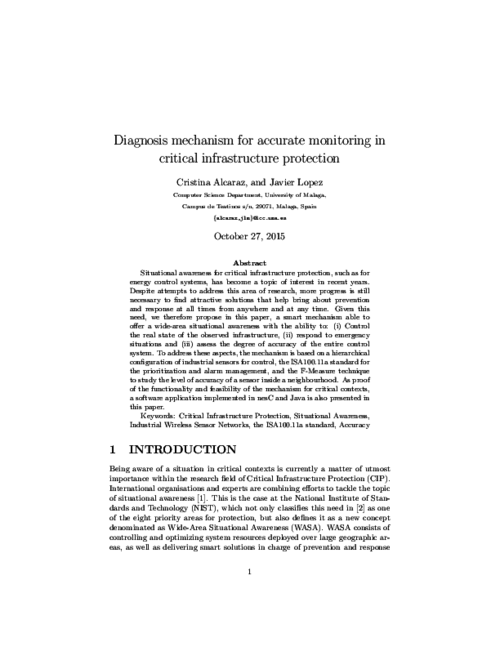
-
"Cloud-Assisted Dynamic Resilience for Cyber-Physical Control Systems",
IEEE Wireless Communications, vol. 25, no. 1, IEEE, pp. 76-82, 02/2018. DOI
 (I.F.: 11)More..
(I.F.: 11)More.. -
"Managing Incidents in Smart Grids à la Cloud",
IEEE CloudCom 2011, IEEE Computer Society, pp. 527-531, Nov-Dec 2011. DOI
 More..
More..Abstract
During the last decade, the Cloud Computing paradigm has emerged as a panacea for many problems in traditional IT infrastructures. Much has been said about the potential of Cloud Computing in the Smart Grid context, but unfortunately it is still relegated to a second layer when it comes to critical systems. Although the advantages of outsourcing those kind of applications to the cloud is clear, data confidentiality and operational privacy stand as mayor drawbacks. In this paper, we try to give some hints on which security mechanisms and more specific, which cryptographic schemes, will help a better integration of Smart Grids and Clouds. We propose the use of Virtual SCADA in the Cloud (VS-Cloud) as a mean to improve reliability and efficiency whilst maintaining the same protection level as in traditional SCADA architectures.
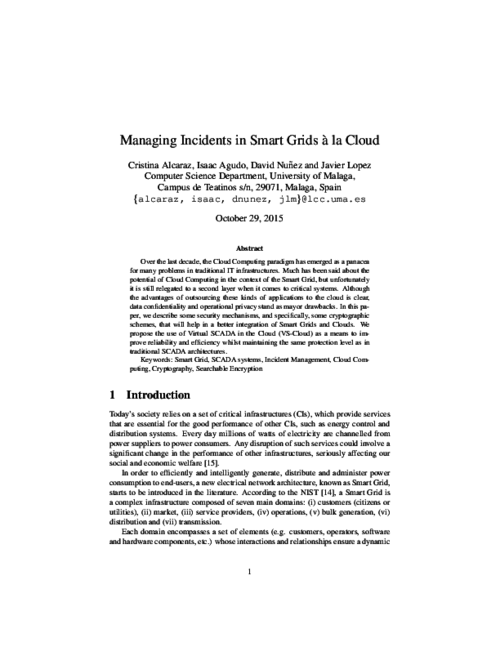
-
"Current Cyber-Defense Trends in Industrial Control Systems",
Computers & Security Journal, vol. 87, Elsevier, 11/2019. DOI
 (I.F.: 3.579)More..
(I.F.: 3.579)More..Abstract
Advanced Persistent Threats (APTs) have become a serious hazard for any critical infrastructure, as a single solution to protect all industrial assets from these complex attacks does not exist. It is then essential to understand what are the defense mechanisms that can be used as a first line of defense. For this purpose, this article will firstly study the spectrum of attack vectors that APTs can use against existing and novel elements of an industrial ecosystem. Afterwards, this article will provide an analysis of the evolution and applicability of Intrusion Detection Systems (IDS) that have been proposed in both the industry and academia.
Impact Factor: 3.579Journal Citation Reports® Science Edition (Thomson Reuters, 2019)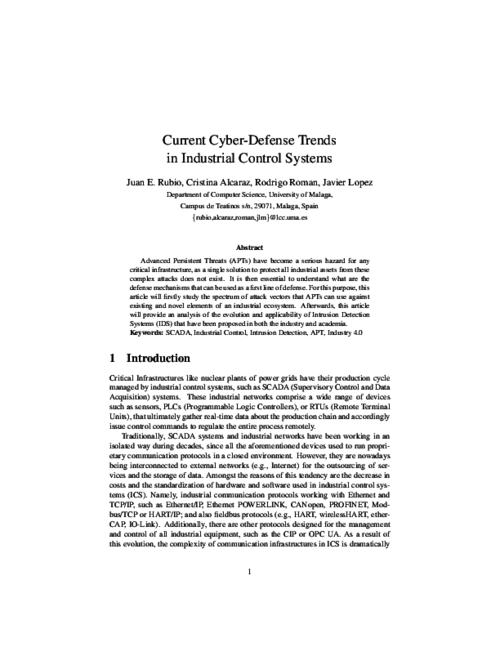
-
"Cyber-Physical Systems for Wide-Area Situational Awareness",
Cyber-Physical Systems: Foundations, Principles and Applications, no. Intelligent Data-Centric Systems, Academic Press, pp. 305 - 317, 2017. DOI
 More..
More..Abstract
Abstract Cyber-physical systems (CPSs), integrated in critical infrastructures, could provide the minimal services that traditional situational awareness (SA) systems demand. However, their application in SA solutions for the protection of large control distributions against unforeseen faults may be insufficient. Dynamic protection measures have to be provided not only to locally detect unplanned deviations but also to prevent, respond, and restore from these deviations. The provision of these services as an integral part of the SA brings about a new research field known as wide-area situational awareness (WASA), highly dependent on CPSs for control from anywhere across multiple interconnections, and at any time. Thus, we review the state-of-the art of this new paradigm, exploring the different preventive and corrective measures considering the heterogeneity of CPSs, resulting in a guideline for the construction of automated WASA systems.
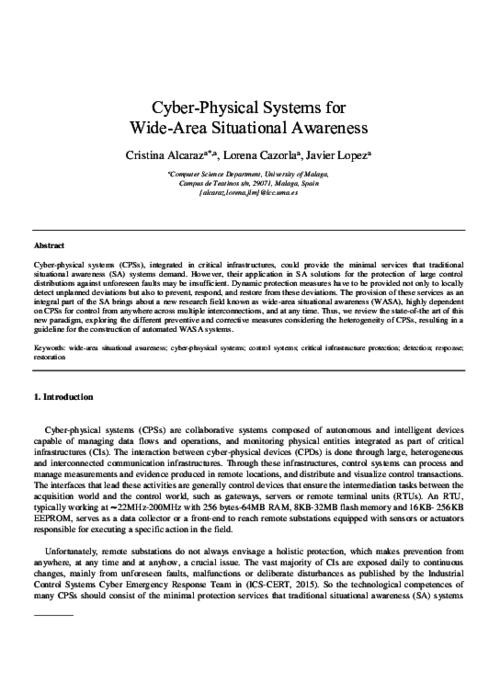
-
"Wide-Area Situational Awareness for Critical Infrastructure Protection",
IEEE Computer, vol. 46, no. 4, IEEE Computer Society, pp. 30-37, 2013. DOI
 (I.F.: 1.438)More..
(I.F.: 1.438)More..Abstract
Combining a wide-area situational awareness (WASA) methodological framework with a set of requirements for awareness construction can help in the development and commissioning of future WASA cyberdefense solutions
Impact Factor: 1.438Journal Citation Reports® Science Edition (Thomson Reuters, 2013)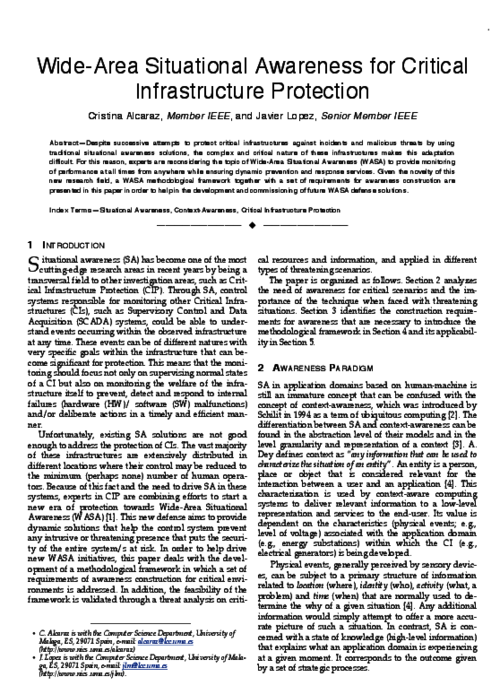
-
"Covert Channels-based Stealth Attacks in Industry 4.0",
IEEE Systems Journal., vol. 13, issue 4, IEEE, pp. 3980-3988, 12/2019. DOI
 (I.F.: 3.987)More..
(I.F.: 3.987)More..Abstract
Industry 4.0 advent opens several cyber-threats scenarios originally designed for classic information technology, drawing the attention to the serious risks for the modern industrial control networks. To cope with this problem, in this paper we address the security issues related to covert channels applied to industrial networks, identifying the new vulnerability points when information technologies converge with operational technologies such as edge computing infrastructures. Specifically, we define two signaling strategies where we exploit the Modbus/TCP protocol as target to set up a covert channel. Once the threat channel is established, passive and active offensive attacks (i.e. data exfiltration and command an control, respectively) are further exploited by implementing and testing them on a real Industrial Internet of Things testbed. The experimental results highlight the potential damage of such specific threats, and the easy extrapolation of the attacks to other types of channels in order to show the new risks for Industry 4.0. Related to this, we discuss some countermeasures to offer an overview of possible mitigation and defense measures.
Impact Factor: 3.987Journal Citation Reports® Science Edition (Thomson Reuters, 2019)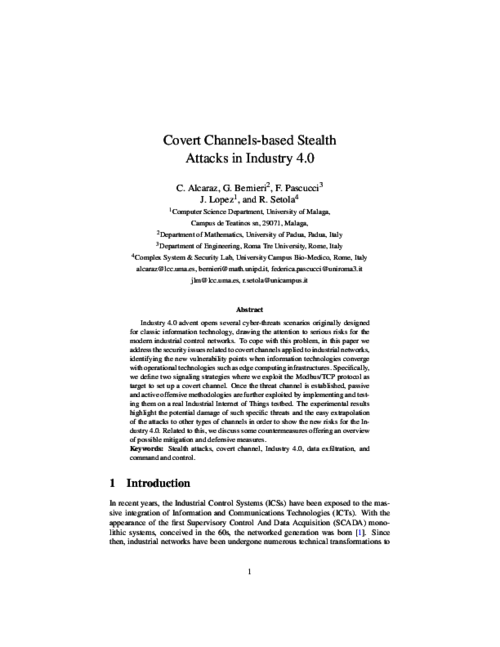
-
"Cyber Stealth Attacks in Critical Information Infrastructures",
IEEE Systems Journal, vol. 12, issue 2, IEEE, pp. 1778-1792, 06/2018. DOI
 (I.F.: 4.463)More..
(I.F.: 4.463)More..Abstract
Current Critical Infrastructures (CIs) are complex interconnected industrial systems that, in recent years, have incorporated information and communications technologies such as connection to the Internet and commercial off-the-shelf components. This makes them easier to operate and maintain, but exposes them to the threats and attacks that inundate conventional networks and systems. This paper contains a comprehensive study on the main stealth attacks that threaten CIs, with a special focus on Critical Information Infrastructures (CIIs). This type of attack is characterized by an adversary who is able to finely tune his actions to avoid detection while pursuing his objectives. To provide a complete analysis of the scope and potential dangers of stealth attacks we determine and analyze their stages and range, and we design a taxonomy to illustrate the threats to CIs, offering an overview of the applicable countermeasures against these attacks. From our analysis we understand that these types of attacks, due to the interdependent nature of CIs, pose a grave danger to critical systems where the threats can easily cascade down to the interconnected systems.
Impact Factor: 4.463Journal Citation Reports® Science Edition (Thomson Reuters, 2018)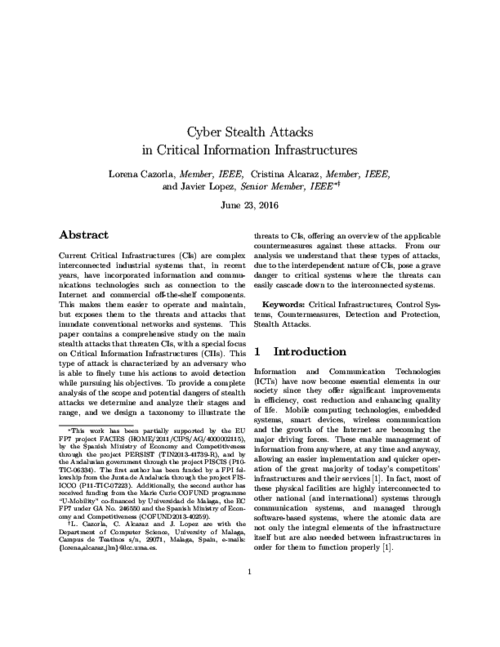
-
"Preventing Advanced Persistent Threats in Complex Control Networks",
European Symposium on Research in Computer Security, vol. 10493, 22nd European Symposium on Research in Computer Security (ESORICS 2017), pp. 402-418, 09/2017.
 More..
More..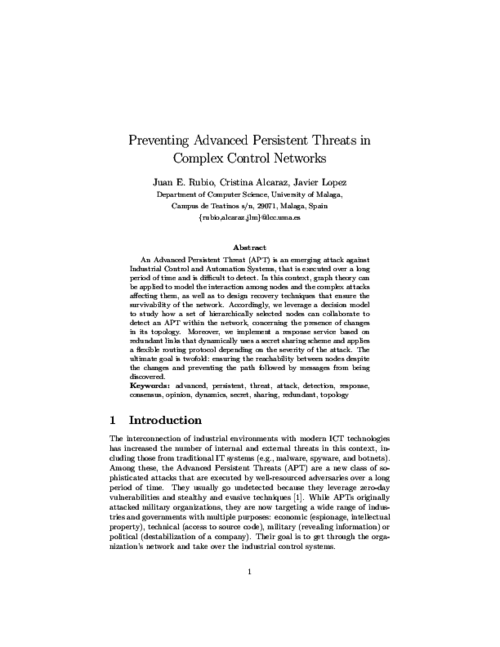
-
"Tracking Advanced Persistent Threats in Critical Infrastructures through Opinion Dynamics",
European Symposium on Research in Computer Security (ESORICS 2018), vol. 11098, Springer, pp. 555-574, 08/2018. DOI
 More..
More..Abstract
Advanced persistent threats pose a serious issue for modern industrial environments, due to their targeted and complex attack vectors that are difficult to detect. This is especially severe in critical infrastructures that are accelerating the integration of IT technologies. It is then essential to further develop effective monitoring and response systems that ensure the continuity of business to face the arising set of cyber-security threats. In this paper, we study the practical applicability of a novel technique based on opinion dynamics, that permits to trace the attack throughout all its stages along the network by correlating different anomalies measured over time, thereby taking the persistence of threats and the criticality of resources into consideration. The resulting information is of essential importance to monitor the overall health of the control system and correspondingly deploy accurate response procedures.
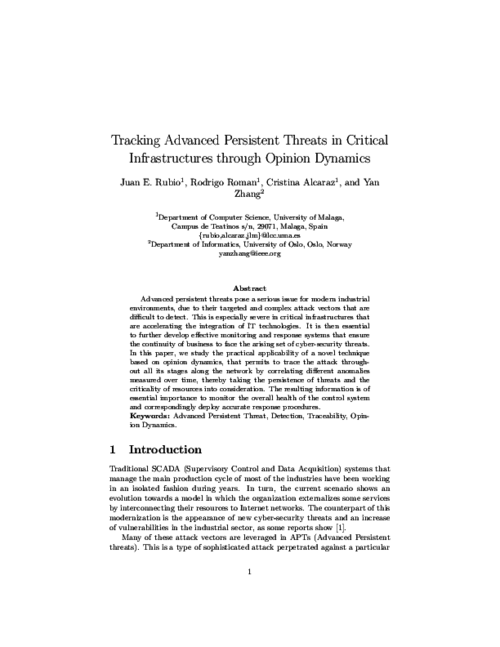
-
"Addressing Situational Awareness in Critical Domains of a Smart Grid",
6th International Conference on Network and System Security (NSS 2012), LNCS 7645 7645, Springer-Verlag, pp. 58-71, November 2012. DOI
 More..
More..Abstract
Control and situational awareness are two very important aspects within critical control systems, since potential faults or anomalous behaviors could lead to serious consequences by hiding the real status of supervised critical infrastructures. Examples of these infrastructures are energy generation, transmission or distribution systems that belong to Smart Grid systems. Given the importance of these systems for social welfare and its economy, a situational awareness-based model, composed of a set of current technologies, is proposed in this paper. The model focuses on addressing and offering a set of minimum services for protection, such as prevention, detection, response, self-evaluation and maintenance, thereby providing a desirable protection in unplanned situations.
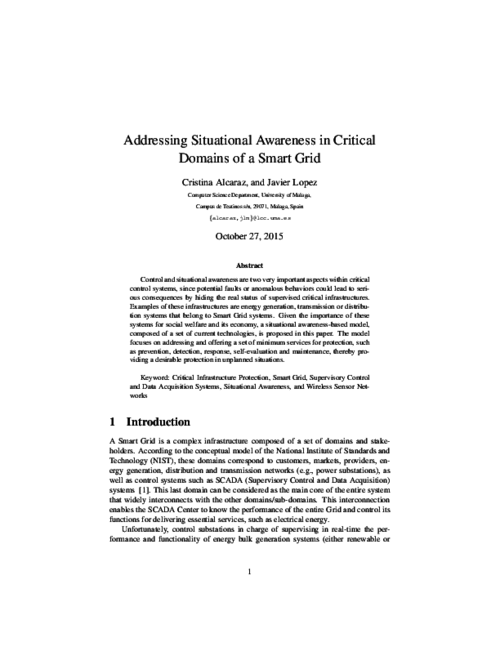
-
"Tracking APTs in Industrial Ecosystems: A Proof of Concept",
Journal of Computer Security, vol. 27, issue 5, Elsevier, pp. 521-546, 09/2019.
 (I.F.: 3.579)More..
(I.F.: 3.579)More.. -
"Policy Enforcement System for Secure Interoperable Control in Distributed Smart Grid Systems",
Journal of Network and Computer Applications, vol. 59, Elsevier, pp. 301–314, 01/2016.
 (I.F.: 3.500)More..
(I.F.: 3.500)More..Abstract
Interoperability of distributed systems in charge of monitoring and maintaining the different critical domains belonging to Smart Grid scenarios comprise the central topic of this paper. Transparency in control transactions under a secure and reliable architecture is the aim of the policy enforcement system proposed here. The approach is based on the degree of observation of a context and on the role-based access control model defined by the IEC-62351-8 standard. Only authenticated and authorised entities are able to take control of those distributed elements (e.g., IEC-61850 objects) located at distant geographical locations and close to the critical infrastructures (e.g., substations). To ensure the effectiveness of the approach, it is built on graphical-theoretical formulations corresponding to graph theory, where it is possible to illustrate power control networks through power-law distributions whose monitoring relies on structural controllability theory. The interconnection of these distributions is subject to a network architecture based on the concept of the supernode where the interoperability depends on a simple rule-based expert system. This expert system focuses not only on accepting or denying access, but also on providing the means to attend to extreme situations, avoiding, as much as possible, the overloading of the communication. Through one practical study we also show the functionalities of the approach and the benefits that the authorisation itself can bring to the interoperability.
Impact Factor: 3.500Journal Citation Reports® Science Edition (Thomson Reuters, 2016)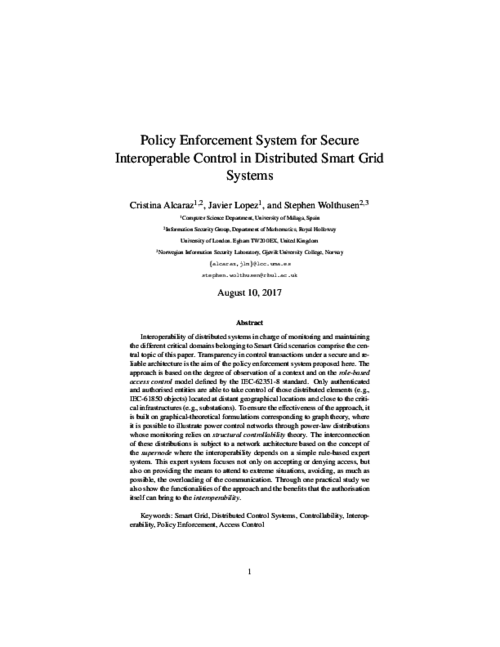
-
"Dynamic Restoration in Interconnected RBAC-based Cyber-Physical Control Systems",
Proceedings of the 13th International Joint Conference on e-Business and Telecommunications (SECRYPT 2016), pp. 19-27, 2016. DOI
 More..
More..Abstract
Increasingly, automatic restoration is an indispensable security measure in control systems (e.g. those used in critical infrastructure sectors) due to the importance of ensuring the functionality of monitoring infrastructures. Modernizing the interconnection of control systems to provide interoperability between different networks, at a low cost, is also a critical requirement in control systems. However, automated recovery mechanisms are currently costly, and ensuring interoperability particularly at a low cost remains a topic of scientific challenge. This is the gap we seek to address in this paper. More specifically, we propose a restoration model for interconnected contexts, taking into account the theory of supernode and structural controllability, as well as the recommendations given by the IEC-62351-8 standard (which are mainly based on the implementation of a role-based access control system).
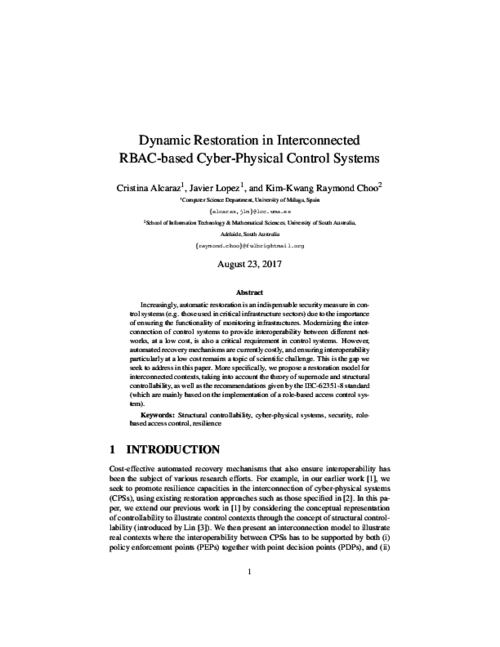
-
"Access control for cyber-physical systems interconnected to the cloud",
Computer Networks, vol. 134, Elsevier, pp. 46 - 54, 2018. DOI
 (I.F.: 3.03)More..
(I.F.: 3.03)More.. -
"Resilient Interconnection in Cyber-Physical Control Systems",
Computers & Security, vol. 71, Elsevier, pp. 2-14, 11/2017. DOI
 (I.F.: 2.650)More..
(I.F.: 2.650)More..Abstract
Secure interconnection between multiple cyber-physical systems has become a fundamental requirement in many critical infrastructures, where security may be centralized in a few nodes of the system. These nodes could, for example, have the mission of addressing the authorization services required for access in highlyrestricted remote substations. For this reason, the main aim of this paper is to unify all these features, together with the resilience measures so as to provide control at all times under a limited access in the field and avoid congestion. Concretely, we present here an optimal reachability-based restoration approach, capable of restoring the structural control in linear times taking into account: structural controllability, the supernode theory, the good practices of the IEC-62351 standard and the contextual conditions. For context management, a new attribute is specified to provide a more complete authorization service based on a practical policy, role and attribute-based access control (PBAC + RBAC + ABAC). To validate the approach, two case studies are also discussed under two strategic adversarial models.
Impact Factor: 2.650Journal Citation Reports® Science Edition (Thomson Reuters, 2017)
-
"Smart Control of Operational Threats in Control Substations",
Computers & Security, vol. 38, Elsevier, pp. 14-27, OCT 2013. DOI
 (I.F.: 1.172)More..
(I.F.: 1.172)More..Abstract
Any deliberate or unsuitable operational action in control tasks of critical infrastructures, such as energy generation, transmission and distribution systems that comprise sub-domains of a Smart Grid, could have a significant impact on the digital economy: without energy, the digital economy cannot live. In addition, the vast majority of these types of critical systems are configured in isolated locations where their control depends on the ability of a few, supposedly trustworthy, human operators. However, this assumption of reliabilty is not always true. Malicious human operators (criminal insiders) might take advantage of these situations to intentionally manipulate the critical nature of the underlying infrastructure. These criminal actions could be not attending to emergency events, inadequately responding to incidents or trying to alter the normal behaviour of the system with malicious actions. For this reason, in this paper we propose a smart response mechanism that controls human operators’ operational threats at all times. Moreover, the design of this mechanism allows the system to be able to not only evaluate by itself, the situation of a particular scenario but also to take control when areas are totally unprotected and/or isolated. The response mechanism, which is based on Industrial Wireless Sensor Networks (IWSNs) for the constant monitoring of observed critical infrastructures, on reputation for controlling human operators’ actions, and on the ISA100.11a standard for alarm management, has been implemented and simulated to evaluate its feasibility for critical contexts.
Impact Factor: 1.172Journal Citation Reports® Science Edition (Thomson Reuters, 2013)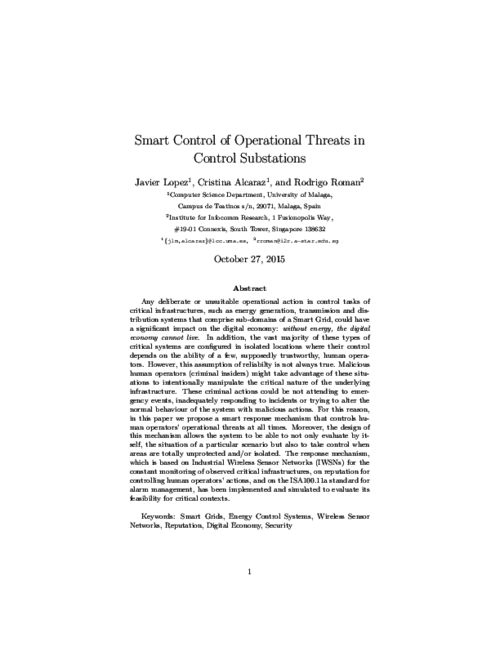
-
"Enhancing Security and Dependability of Industrial Networks with Opinion Dynamics",
European Symposium on Research in Computer Security (ESORICS2019), vol. 11736, pp. 263-280, 09/2019. DOI
 More..
More..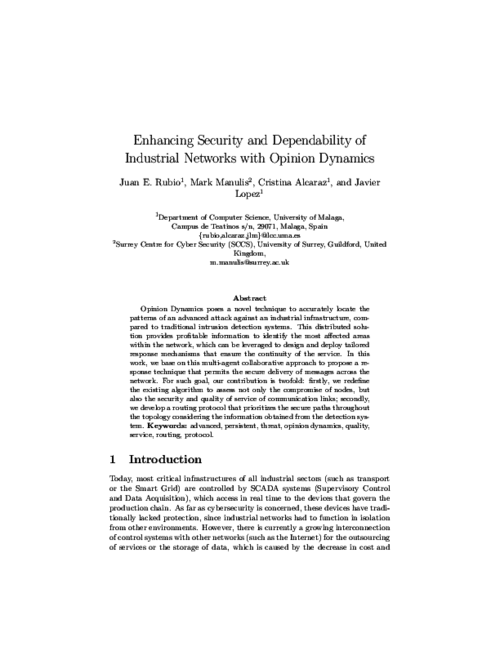
-
"Addressing Security in OCPP: Protection Against Man-in-the-Middle Attacks",
9th IFIP International Conference on New Technologies, Mobility & Security, 2018.
 More..
More..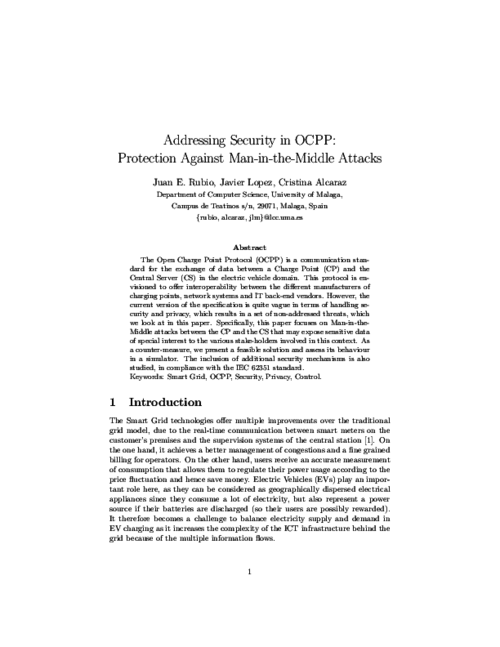
-
"OCPP Protocol: Security Threats and Challenges",
IEEE Transactions on Smart Grid, vol. 8, issue 5, IEEE, pp. 2452 - 2459, 02/2017. DOI
 (I.F.: 7.364)More..
(I.F.: 7.364)More..Abstract
One benefit postulated for the adoption of Electric Vehicles (EVs) is their ability to act as stabilizing entities in smart grids through bi-directional charging, allowing local or global smoothing of peaks and imbalances. This benefit, however, hinges indirectly on the reliability and security of the power flows thus achieved. Therefore this paper studies key security properties of the alreadydeployed Open Charge Point Protocol (OCPP) specifying communication between charging points and energy management systems. It is argued that possible subversion or malicious endpoints in the protocol can also lead to destabilization of power networks. Whilst reviewing these aspects, we focus, from a theoretical and practical standpoint, on attacks that interfere with resource reservation originating with the EV, which may also be initiated by a man in the middle, energy theft or fraud. Such attacks may even be replicated widely, resulting in over- or undershooting of power network provisioning, or the (total/partial) disintegration of the integrity and stability of power networks.
Impact Factor: 7.364Journal Citation Reports® Science Edition (Thomson Reuters, 2017)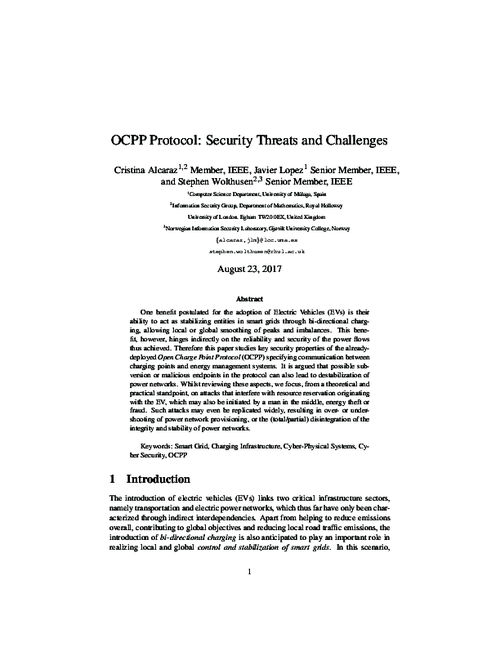
- Citekey Alcaraz2010a under specific IETF standards not found
-
"Recommender System for Privacy-Preserving Solutions in Smart Metering",
Pervasive and Mobile Computing, vol. 41, Pervasive and Mobile Computing, pp. 205-218, 10/2017.
 (I.F.: 2.974)More..
(I.F.: 2.974)More..Abstract
Nowadays, Smart Grid is envisaged to provide several benefits to both customers and grid operators. However, Smart Meters introduce many privacy issues if consumption data is analysed. In this paper we analyse the main techniques that address privacy when collecting electricity readings. In addition to privacy, it is equally important to preserve efficiency to carry on with monitoring operations, so further control requirements and communication protocols are also studied. Our aim is to provide guidance to installers who intend to integrate such mechanisms on the grid, presenting an expert system to recommend an appropriate deployment strategy.
Impact Factor: 2.974Journal Citation Reports® Science Edition (Thomson Reuters, 2017)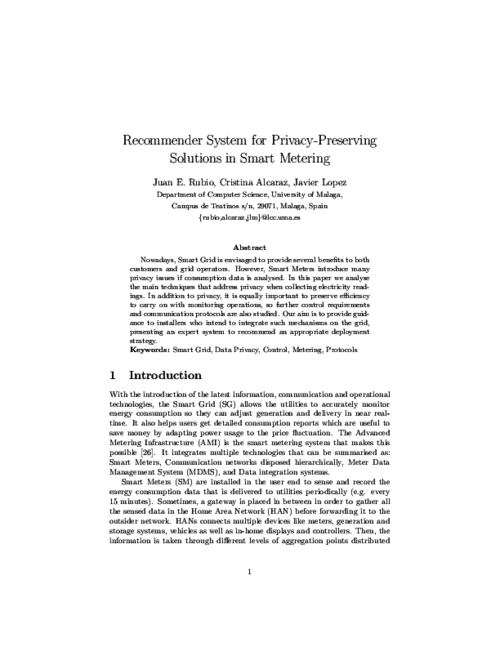
-
"Selecting Privacy Solutions to Prioritise Control in Smart Metering Systems",
The 11th International Conference on Critical Information Infrastructures Security, vol. 10242, pp. 176-188, 2017.
 More..
More..Abstract
The introduction of the Smart Grid brings with it several benefits to society, because its bi-directional communication allows both users and utilities to have better control over energy usage. However, it also has some privacy issues with respect to the privacy of the customers when analysing their consumption data. In this paper we review the main privacy-preserving techniques that have been proposed and compare their efficiency, to accurately select the most appropriate ones for undertaking control operations. Both privacy and performance are essential for the rapid adoption of Smart Grid technologies.
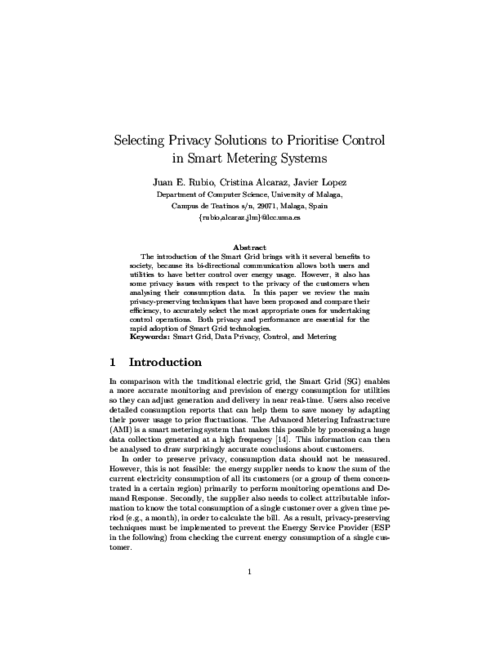
-
"Towards Privacy Protection in Smart Grid",
Wireless Personal Communications, vol. 73, Springer, pp. 23-50, Nov 2013, 2012. DOI
 (I.F.: 0.428)More..
(I.F.: 0.428)More..Abstract
The smart grid is an electronically controlled electrical grid that connects power generation, transmission, distribution, and consumers using information communication technologies. One of the key characteristics of the smart grid is its support for bi-directional information flow between the consumer of electricity and the utility provider. This two-way interaction allows electricity to be generated in real-time based on consumers’ demands and power requests. As a result, consumer privacy becomes an important concern when collecting energy usage data with the deployment and adoption of smart grid technologies. To protect such sensitive information it is imperative that privacy protection mechanisms be used to protect the privacy of smart grid users. We present an analysis of recently proposed smart grid privacy solutions and identify their strengths and weaknesses in terms of their implementation complexity, efficiency, robustness, and simplicity.
Impact Factor: 0.428Journal Citation Reports® Science Edition (Thomson Reuters, 2012)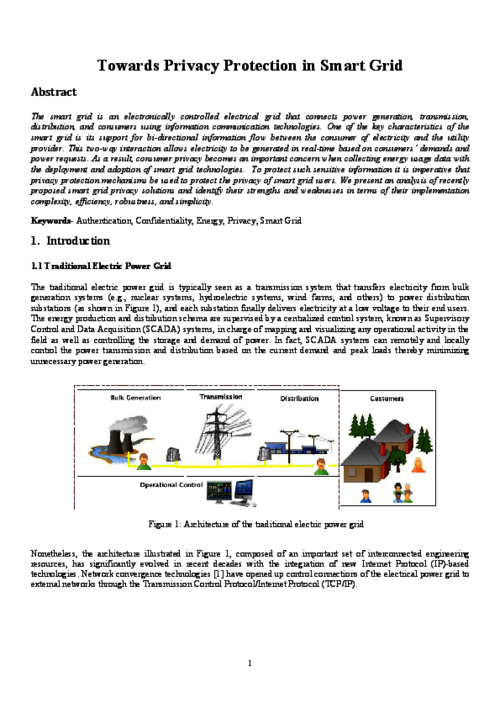
-
"Smart Grid Privacy: Issues and Solutions",
21st International Conference on Computer Communications and Networks (ICCCN), IEEE Computer Society, pp. 1-5, Jul 2012. DOI More..
More..Abstract
Migration to an electronically controlled electrical grid to transmit, distribute, and deliver power to consumers has helped enhance the reliability and efficiency of conventional electricity systems. At the same time, this digitally enabled technology called the Smart Grid has brought new challenges to businesses and consumers alike. A key component of such a grid is the smart-metering technology, which is used to collect energy consumption data from homes and transmitting it back to power distributors. A crucial concern is the privacy related to the collection and use of energy consumption data. We present an analysis of Smart Grid privacy issues and discuss recently proposed solutions that can protect the privacy of Smart Grid users.
-
"SealedGRID: A Secure Interconnection of Technologies for Smart Grid Applications",
14th International Conference on Critical Information Infrastructures Security (CRITIS 2019), vol. 11777, Springer, Cham, pp. 169-175, 12/2019. DOI
 More..
More..Abstract
In recent years, the Smart Grid has increasingly integrated cutting-edge technologies that generate several benefits for all the stakeholders involved, such as a more accurate billing system and enhanced Demand Response procedures. However, this modernization also brings with it diverse cyber security and privacy issues, which sets the necessity for developing a security platform specifically tailored to this scenario. In this paper, we present SealedGRID, which proposes a flexible architecture that provides security services at all levels by implementing Trusted Execution Environments on their devices, together with advanced authentication and authorization mechanisms, as well as privacy preserving techniques. These technologies are presented in depth and a final security analysis is conducted, which highlights the contributions of this project.
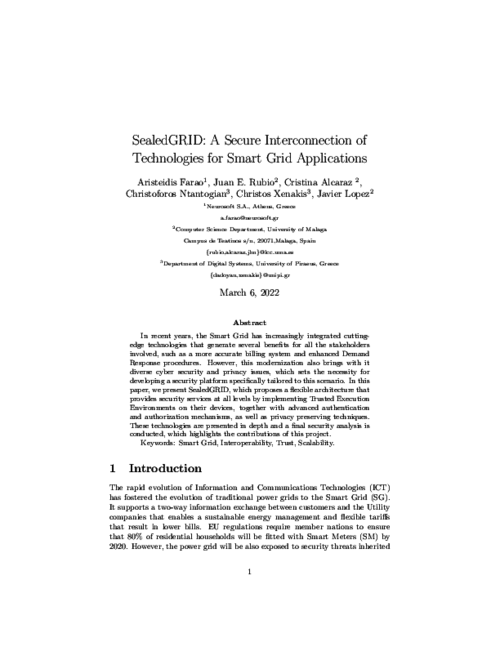
-
"Structural Controllability of Networks for Non-Interactive Adversarial Vertex Removal",
8th International Conference on Critical Information Infrastructures Security, vol. 8328, Springer, pp. 120-132, 2013. DOI
 More..
More..Abstract
The problem of controllability of networks arises in a number of different domains, including in critical infrastructure systems where control must be maintained continuously. Recent work by Liu et al. has renewed interest in the seminal work by Lin on structural controllability, providing a graph-theoretical interpretation. This allows the identification of driver nodes capable of forcing the system into a desired state, which implies an obvious target for attackers wishing to disrupt the network control. Several methods for identifying driver nodes exist, but require undesirable computational complexity. In this paper, we therefore investigate the ability to regain or maintain controllability in the presence of adversaries able to remove vertices and implicit edges of the controllability graph. For this we rely on the POWER DOMINATING SET (PDS) formulation for identifying the control structure and study different attack strategies for multiple network models. As the construction of a PDS for a given graph is not unique, we further investigate different strategies for PDS construction, and provide a simulative evaluation.
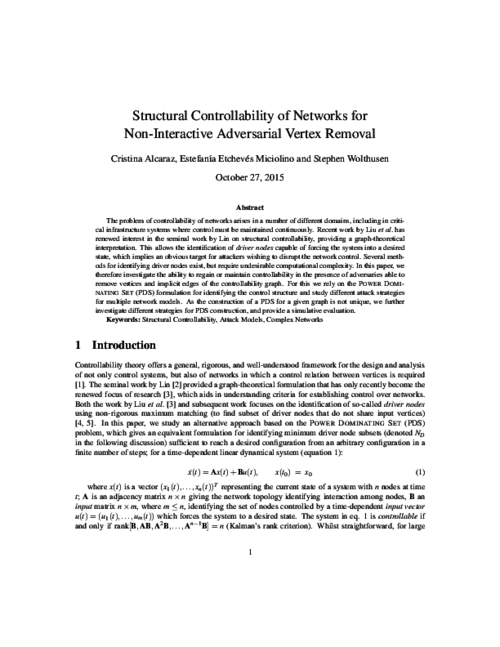
-
"Multi-Round Attacks on Structural Controllability Properties for Non-Complete Random Graphs",
The 16th Information Security Conference (ISC), vol. 7807, Springer, pp. 140–151, 09/2015. DOI
 More..
More..Abstract
The notion of controllability, informally the ability to force a system into a desired state in a finite time or number of steps, is most closely associated with control systems such as those used to maintain power networks and other critical infrastructures, but has wider relevance in distributed systems. It is clearly highly desirable to understand under which conditions attackers may be able to disrupt legitimate control, or to force overriding controllability themselves. Following recent results by Liu et al., there has been considerable interest also in graph-theoretical interpretation of Kalman controllability originally introduced by Lin, structural controllability. This permits the identification of sets of driver nodes with the desired state-forcing property, but determining such nodes is aW[2]-hard problem. To extract these nodes and represent the control relation, here we apply the POWER DOMINATING SET problem and investigate the effects of targeted iterative multiple-vertex removal. We report the impact that different attack strategies with multiple edge and vertex removal will have, based on underlying non-complete graphs, with an emphasis on power-law random graphs with different degree sequences.
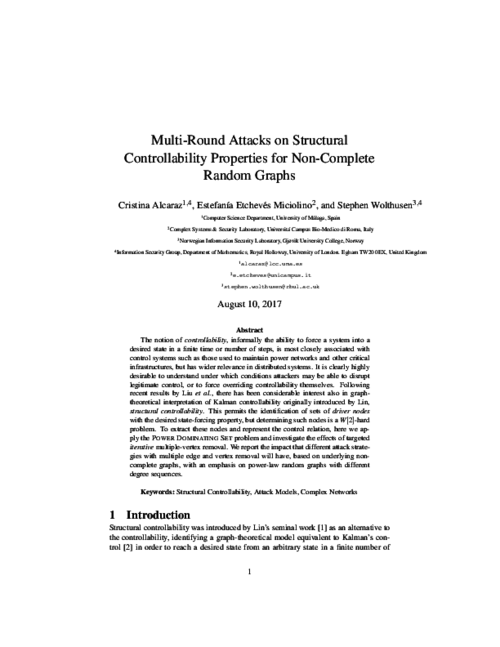
-
"Safeguarding Structural Controllability in Cyber-Physical Control Systems",
The 21st European Symposium on Research in Computer Security (ESORICS 2016), vol. 9879, Springer, pp. 471-489, 2016.
 More..
More..Abstract
Automatic restoration of control wireless networks based on dynamic cyber-physical systems has become a hot topic in recent years, since most of their elements tend to have serious vulnerabilities that may be exploited by attackers. In fact, any exploitation may rapidly extend to the entire control network due to its problem of non-locality, where control properties of a system and its structural controllability can disintegrate over time. Unfortunately, automated self-healing processes may become costly procedures in which the reliability of the strategies and the time-critical of any recovery of the control can become key factors to re-establish the control properties in due time. This operational need is precisely the aim of this paper, in which four reachability-based recovery strategies from a thereotical point of view are proposed so as to find the best option/s in terms of optimization, robustness and complexity. To do this, new definitions related to structural controllability in relation to the type of distribution of the network and its control load capacity are given in this paper, resulting in an interesting practical study.
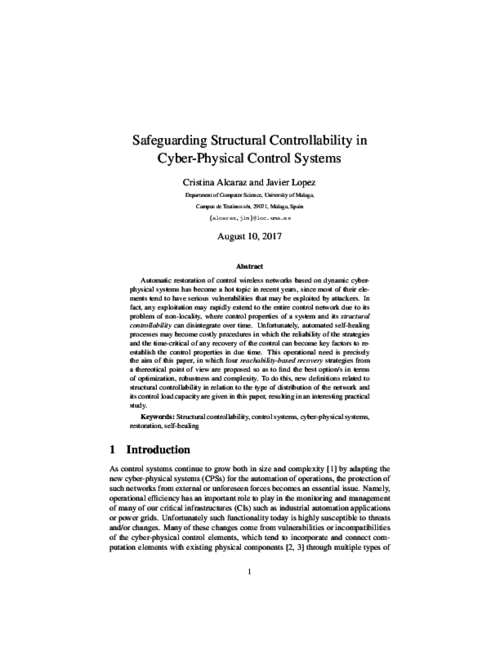
-
"Resilient Industrial Control Systems based on Multiple Redundancy",
International Journal of Critical Infrastructures (IJCIS), vol. 13, no. 2/3, Inderscience Publisher, pp. 278 - 295, 11/2017. DOI More..
More..Abstract
The incessant search for cost-effective recovery solutions for structural controllability has led to one of the most challenging research areas within the field of critical infrastructure protection. The resilience of large heterogeneous distributions, like industrial control scenarios, is proving to be a complicated mission due to the inherent non-locality problems of structural controllability and its susceptibility to advanced threats. To address these issues, this paper proposes a new repair approach based on multiple redundant pathways and the lessons learnt from the work presented in [1]. From [1], we have adapted the local measures, to combine them with each of the five strategies of remote reconnection described in this paper. To validate the sustainability of the combined approaches, two practical case studies are presented here, showing that a local dependence on a brother driver node together with remote dependence is enough to reach optimal states in linear times.
-
"Recovery of Structural Controllability for Control Systems",
Eighth IFIP WG 11.10 International Conference on Critical Infrastructure Protection, SRI International, Arlington, Virginia, USA , vol. 441, Springer, pp. 47-63, 2014. DOI
 More..
More..Abstract
Fundamental problems in control systems theory are controllability and observability, and designing control systems so that these properties are satisfied or approximated sufficiently. However, it is prudent to as- sume that an attacker will not only be able to subvert measurements but also control the system. Moreover, an advanced adversary with an understanding of the control system may seek to take over control of the entire system or parts thereof, or deny the legitimate operator this capability. The effectiveness of such attacks has been demonstrated in previous work. Indeed, these attacks cannot be ruled out given the likely existence of unknown vulnerabilities, increasing connectivity of nominally air-gapped systems and supply chain issues. The ability to rapidly recover control after an attack has been initiated and to detect an adversary’s presence is, therefore, critical. This paper focuses on the problem of structural controllability, which has recently attracted substantial attention through the equivalent problem of the power dom- inating set introduced in the context of electrical power network control. However, these problems are known to be NP-hard with poor approx- imability. Given their relevance to many networks, especially power networks, this paper studies strategies for the efficient restoration of controllability following attacks and attacker-defender interactions in power-law networks.
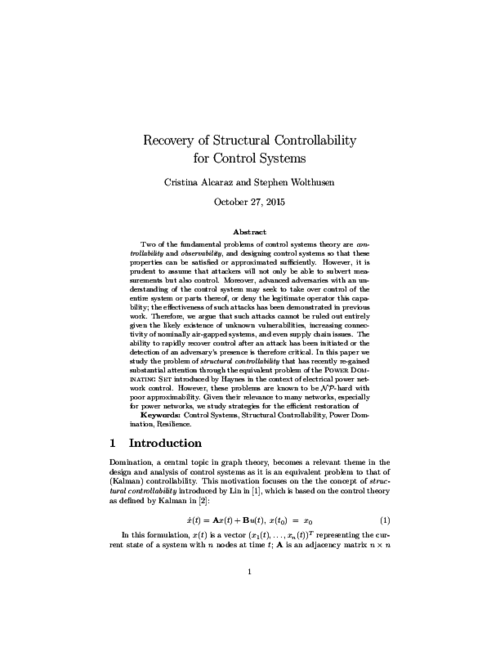
-
"A Resilient Architecture for the Smart Grid",
IEEE Transactions on Industrial Informatics, vol. 14, issue 8, IEEE, pp. 3745-3753, 08/2019, 2018. DOI
 (I.F.: 7.377)More..
(I.F.: 7.377)More..Abstract
The Smart Grid offers many benefits due to the bidirectional communication between the users and the utility company, which makes it possible to perform a fine-grain consumption metering. This can be used for Demand Response purposes with the generation and delivery of electricity in real time. It is essential to rapidly anticipate high peaks of demand or potential attacks, so as to avoid power outages and denial of service, while effectively supplying consumption areas. In this paper, we propose a novel architecture where cloud computing resources are leveraged (and tested in practice) to enable, on the one hand, the consumption prediction through time series forecasting, as well as load balancing to uniformly distribute the demand over a set of available generators. On the other and, it also allows the detection of connectivity losses and intrusions within the control network by using controllability concepts.
Impact Factor: 7.377Journal Citation Reports® Science Edition (Thomson Reuters, 2018)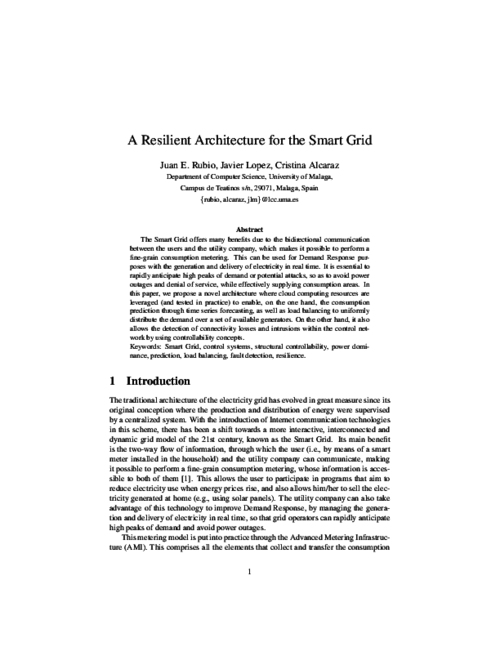
-
"A Three-Stage Analysis of IDS for Critical Infrastructures",
Computers & Security, vol. 55, no. November, Elsevier, pp. 235-250, 2015.
 (I.F.: 1.64)More..
(I.F.: 1.64)More..Abstract
The correct operation of Critical Infrastructures (CIs) is vital for the well being of society, however these complex systems are subject to multiple faults and threats every day. International organizations around the world are alerting the scientific community to the need for protection of CIs, especially through preparedness and prevention mechanisms. One of the main tools available in this area is the use of Intrusion Detection Systems (IDSs). However, in order to deploy this type of component within a CI, especially within its Control System (CS), it is necessary to verify whether the characteristics of a given IDS solution are compatible with the special requirements and constraints of a critical environment. In this paper, we carry out an extensive study to determine the requirements imposed by the CS on the IDS solutions using the Non-Functional Requirements (NFR) Framework. The outcome of this process are the abstract properties that the IDS needs to satisfy in order to be deployed within a CS, which are refined through the identification of satisficing techniques for the NFRs. To provide quantifiable measurable evidence on the suitability of the IDS component for a CI, we broaden our study using the Goal Question Metric (GQM) approach to select a representative set of metrics. A requirements model, refined with satisficing techniques and sets of metrics which help assess, in the most quantifiable way possible, the suitability and performance of a given IDS solution for a critical scenario, constitutes the results of our analysis.
Impact Factor: 1.64Journal Citation Reports® Science Edition (Thomson Reuters, 2015)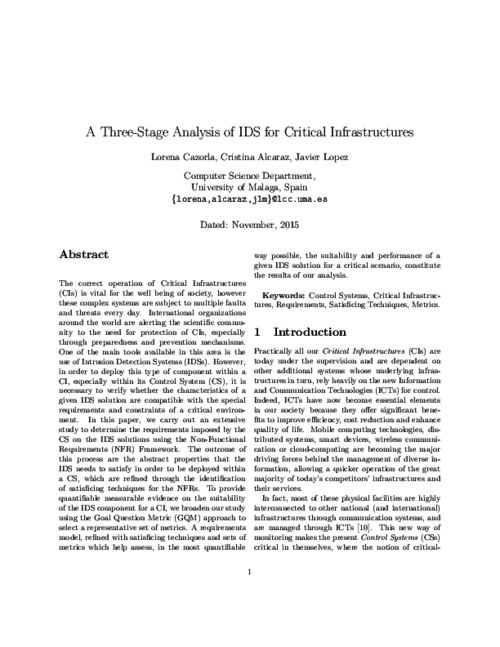
-
"Context-Awareness using Anomaly-based Detectors for Smart Grid Domains",
9th International Conference on Risks and Security of Internet and Systems , vol. 8924, Springer International Publishing, pp. 17-34, 04/2015. DOI
 More..
More..Abstract
Anomaly-based detection applied in strongly interdependent systems, like Smart Grids, has become one of the most challenging research areas in recent years. Early detection of anomalies so as to detect and prevent unexpected faults or stealthy threats is attracting a great deal of attention from the scientific community because it offers potential solutions for context-awareness. These solutions can also help explain the conditions leading up to a given situation and help determine the degree of its severity. However, not all the existing approaches within the literature are equally effective in covering the needs of a particular scenario. It is necessary to explore the control requirements of the domains that comprise a Smart Grid, identify, and even select, those approaches according to these requirements and the intrinsic conditions related to the application context, such as technological heterogeneity and complexity. Therefore, this paper analyses the functional features of existing anomaly-based approaches so as to adapt them, according to the aforementioned conditions. The result of this investigation is a guideline for the construction of preventive solutions that will help improve the context-awareness in the control of Smart Grid domains in the near future.
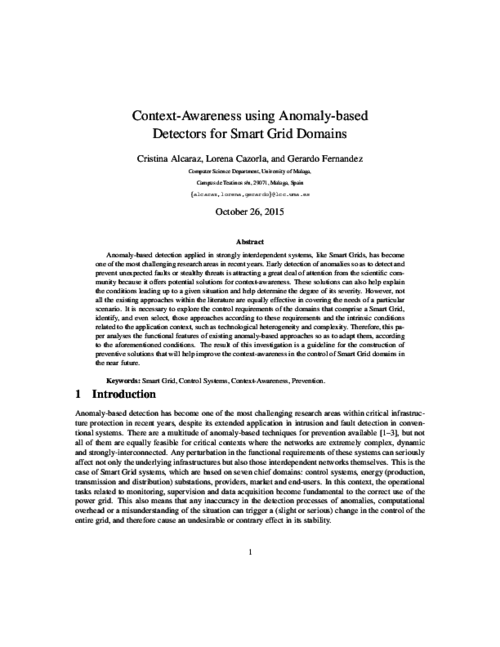
-
"Towards Automatic Critical Infrastructure Protection through Machine Learning",
8th International Conference on Critical Information Infrastructures Security, vol. 8328, Springer, pp. 197-203, 2013. DOI
 More..
More..Abstract
Critical Infrastructure Protection (CIP) faces increasing challenges in number and in sophistication, which makes vital to provide new forms of protection to face every day’s threats. In order to make such protection holistic, covering all the needs of the systems from the point of view of security, prevention aspects and situational awareness should be considered. Researchers and Institutions stress the need of providing intelligent and automatic solutions for protection, calling our attention to the need of providing Intrusion Detection Systems (IDS) with intelligent active reaction capabilities. In this paper, we support the need of automating the processes implicated in the IDS solutions of the critical infrastructures and theorize that the introduction of Machine Learning (ML) techniques in IDS will be helpful for implementing automatic adaptable solutions capable of adjusting to new situations and timely reacting in the face of threats and anomalies. To this end, we study the different levels of automation that the IDS can implement, and outline a methodology to endow critical scenarios with preventive automation. Finally, we analyze current solutions presented in the literature and contrast them against the proposed methodology
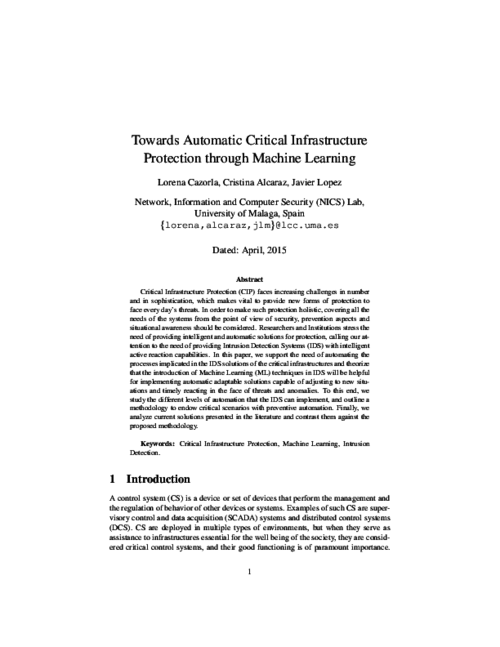
-
"Security Aspects of SCADA and DCS Environments",
Critical Infrastructure Protection: Information Infrastructure Models, Analysis, and Defense, J. Lopez, S.. Wolthunsen, and R. Setola Eds., Advances in Critical Infrastructure Protection: Information Infrastructure Models, Analysis, and Defense. LNCS 7130. 7130, Springer-Verlag, pp. 120-149, September 2012.
 More..
More..Abstract
SCADA Systems can be seen as a fundamental component in Critical Infrastructures, having an impact in the overall performance of other Critical Infrastructures interconnected. Currently, these systems include in their network designs different types of Information and Communication Technology systems (such as the Internet and wireless technologies), not only to modernize operational processes but also to ensure automation and real-time control. Nonetheless, the use of these new technologies will bring new security challenges, which will have a significant impact on both the business process and home users. Therefore, the main purpose of this Chapter is to address these issues and to analyze the interdependencies of Process Control Systems with ICT systems, to discuss some security aspects and to offer some possible solutions and recommendations.
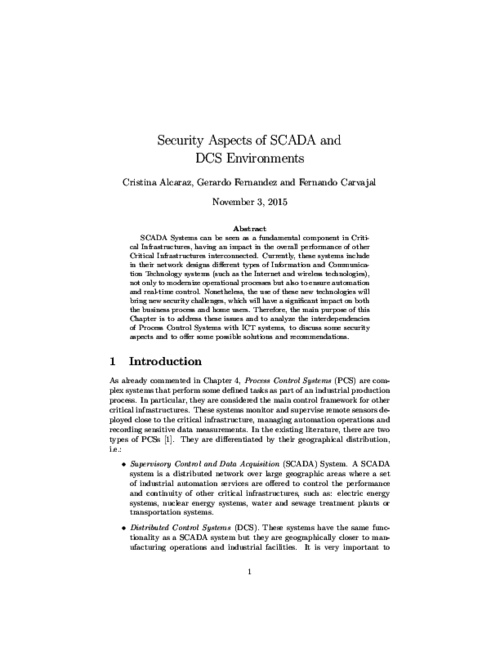
-
"Secure SCADA Framework for the Protection of Energy Control Systems",
Concurrency and Computation Practice & Experience, vol. 23, no. 12, John Wiley & Sons, Inc., pp. 1414-1430, Aug 2011. DOI
 (I.F.: 0.636)More..
(I.F.: 0.636)More..Abstract
Energy distribution systems are becoming increasingly widespread in today’s society. One of the elements that is used to monitor and control these systems are the SCADA (Supervisory Control and Data Acquisition) systems. In particular, these control systems and their complexities, together with the emerging use of the Internet and wireless technologies, bring new challenges that must be carefully considered. Examples of such challenges are the particular bene¯ts of the integration of those new technologies, and also the e®ects they may have on the overall SCADA security. The main task of this paper is to provide a framework that shows how the integration of di®erent state-of-the-art technologies in an energy control system, such as Wireless Sensor Networks (WSNs), Mobile Ad-Hoc Networks (MANETs), and the Internet, can bring some interesting benefits such as status management and anomaly prevention, while maintaining the security of the whole system.
Impact Factor: 0.636Journal Citation Reports® Science Edition (Thomson Reuters, 2011)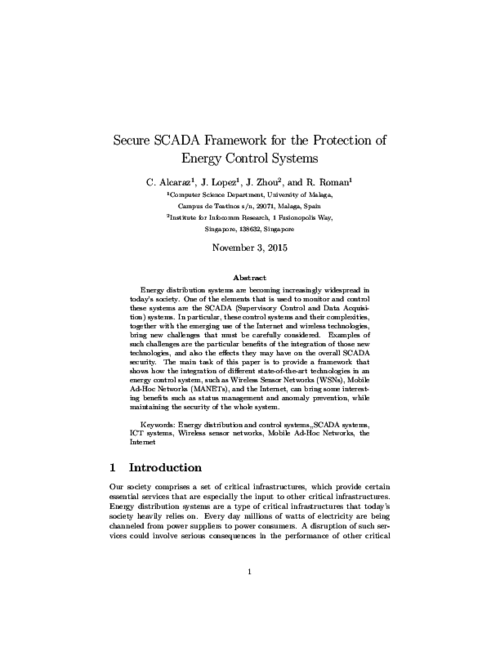
-
"Gestión segura de redes SCADA",
Nuevas tendencias en gestión de redes, Novática, no. 196, CEPIS, pp. 20-25, December, 2008.
 More..
More..Abstract
En el momento que se introduce en el mercado nuevas tecnologías basadas en entornos distribuidos comienzan a surgir en paralelo nuevos problemas de seguridad en los sistemas SCADA (Supervisory Control and Data Acquisition), los cuales monitorizan y gestionan otras infraestructuras de gran complejidad y escala. Un fallo o una interrupción en uno de sus componentes podría suponer un impacto negativo sobre la funcionalidad de otras infraestructuras, por lo que se hace necesario realizar frecuentes análisis de seguridad para así mantener actualizado el conocimiento y proveer recomendaciones y/o soluciones para mitigar o evitar futuras ocurrencias, garantizando una gestión de red fiable y siempre disponible.
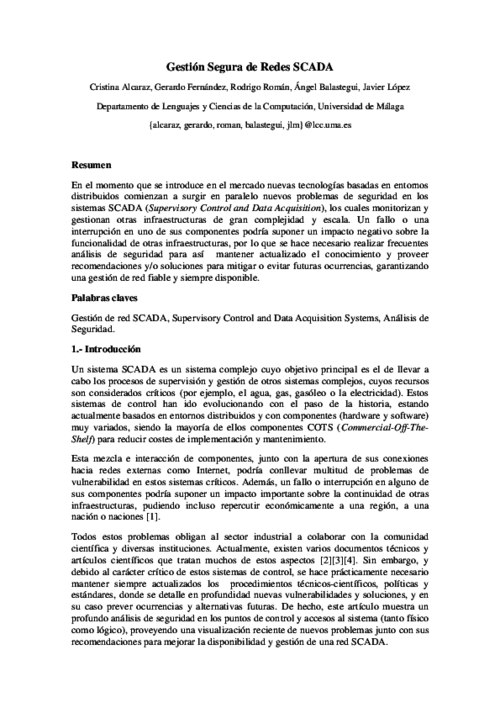
- Citekey alcaraz2015CRI1762 not found
-
"Security of Industrial Sensor Network-based Remote Substations in the context of the Internet of Things",
Ad Hoc Networks, vol. 11, Elsevier, pp. 1091–1104, 2013. DOI
 (I.F.: 1.943)More..
(I.F.: 1.943)More..Abstract
The main objective of remote substations is to provide the central system with sensitive information from critical infrastructures, such as generation, distribution or transmission power systems. Wireless sensor networks have been recently applied in this particular context due to their attractive services and inherent benefits, such as simplicity, reliability and cost savings. However, as the number of control and data acquisition systems that use the Internet infrastructure to connect to substations increases, it is necessary to consider what connectivity model the sensor infrastructure should follow: either completely isolated from the Internet or integrated with it as part of the Internet of Things paradigm. This paper therefore addresses this question by providing a thorough analysis of both security requirements and infrastructural requirements corresponding to all those TCP/IP integration strategies that can be applicable to networks with constrained computational resources.
Impact Factor: 1.943Journal Citation Reports® Science Edition (Thomson Reuters, 2013)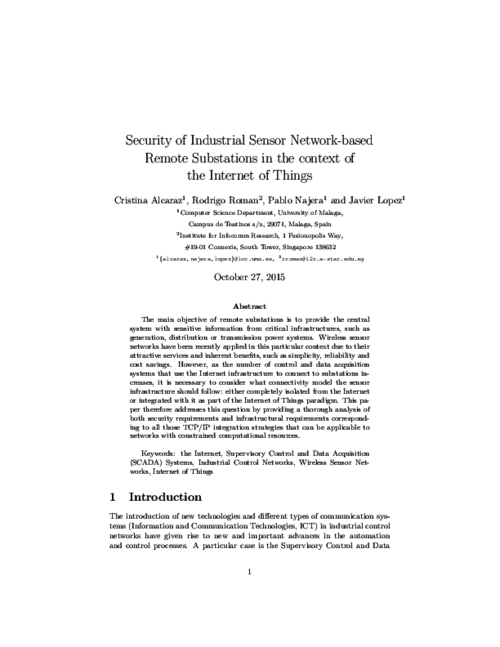
-
"Analysis of Requirements for Critical Control Systems",
International Journal of Critical Infrastructure Protection (IJCIP), vol. 5, Elsevier, pp. 137–145, 2012. DOI
 (I.F.: 0.63)More..
(I.F.: 0.63)More..Abstract
The use of modern information and communications technologies in supervisory control and data acquisition (SCADA) systems used in the critical infrastructure has become an important topic of research. The modernization significantly enhances operational performance, but also introduces security issues and the associated risks. This paper formally analyzes how the introduction of new technologies can impact control systems and ultimately affect the performance of the critical infrastructure systems being controlled. Five control system requirements are identified with the goal of proposing new operational requirements that trade-off performance and security.
Impact Factor: 0.63Journal Citation Reports® Science Edition (Thomson Reuters, 2012)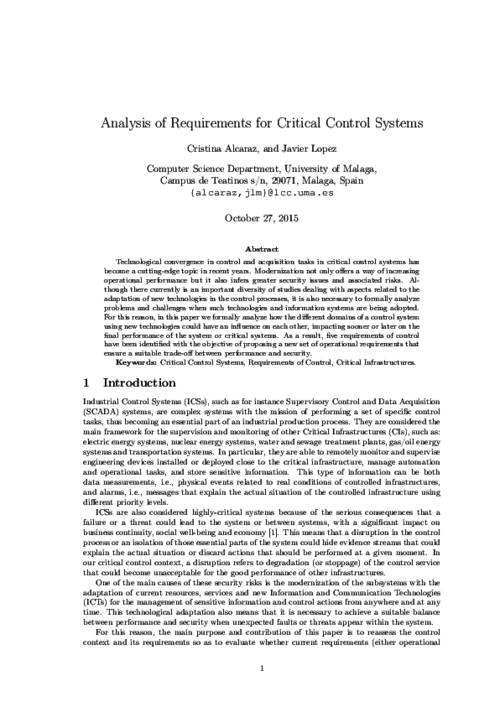
-
"Secure Interoperability in Cyber-Physical Systems",
Security Solutions and Applied Cryptography in Smart Grid Communications, IGI Global, USA, IGI Global, pp. 137-158, 2017. DOI
 More..
More..Abstract
Transparency in control transactions under a secure network architecture is a key topic that must be discussed when aspects related to interconnection between heterogeneous cyber-physical systems (CPSs) arise. The interconnection of these systems can be addressed through an enforcement policy system responsible for managing access control according to the contextual conditions. However, this architecture is not always adequate to ensure a rapid interoperability in extreme crisis situations, and can require an interconnection strategy that permits the timely authorized access from anywhere at any time. To do this, a set of interconnection strategies through the Internet must be studied to explore the ability of control entities to connect to the remote CPSs and expedite their operations, taking into account the context conditions. This research constitutes the contribution of this chapter, where a set of control requirements and interoperability properties are identified to discern the most suitable interconnection strategies.
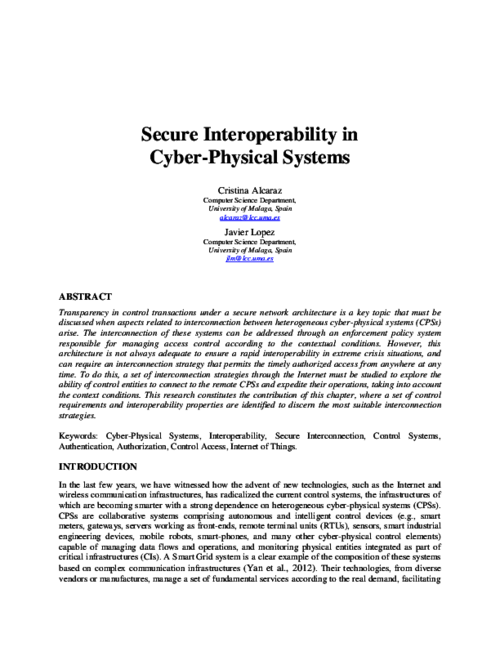
-
"Do Wireless Sensor Networks Need to be Completely Integrated into the Internet?",
3rd CompanionAble Workshop - Future Internet of People, Things and Services (IoPTS) eco-Systems, xxxx, pp. xxxx, December, 2009.
 More..
More..Abstract
Wireless sensor networks are considered as an integral part of the Internet of Things paradigm. Not only they provide a virtual presence to elements of the real world, but also allow any computationalsystem to know about the physical state of those elements thanks to the use of embedded sensors. In order to belong to the Internet of Things, the elements of a sensor network can implement Internet protocols and services such as the TCP/IP stack and web services. Still, a question that must be raised at this point of time is whether all sensor network applications should be completely integrated into the Internet or not. The purpose of this paper is to analyze this question, reviewing the challenges and security requirements of Internet-enabled sensor networks.
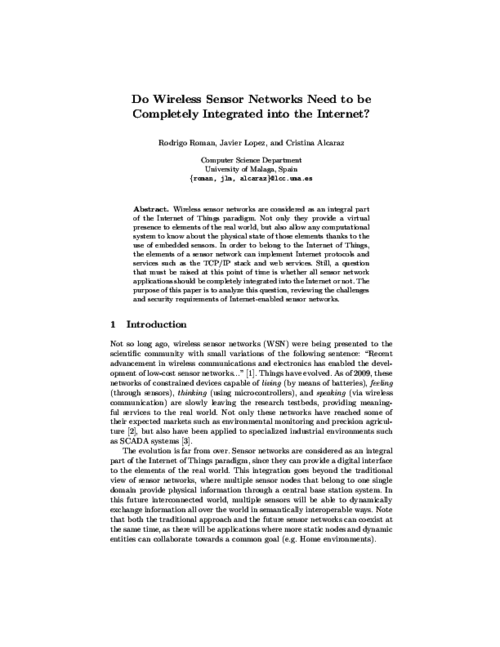
-
"Survey of IoT-enabled Cyberattacks: Assessing Attack Paths to Critical Infrastructures and Services",
IEEE Communications Surveys and Tutorials, vol. 20, issue 4, IEEE, pp. 3453-3495, 07/2018. DOI (I.F.: 22.973)More..
(I.F.: 22.973)More..Abstract
As the deployment of Internet of Things (IoT) is experiencing an exponential growth, it is no surprise that many recent cyber attacks are IoT-enabled: The attacker initially exploits some vulnerable IoT technology as a first step towards compromising a critical system that is connected, in some way, with the IoT. For some sectors, like industry, smart grids, transportation and medical services, the significance of such attacks is obvious, since IoT technologies are part of critical backend systems. However, in sectors where IoT is usually at the enduser side, like smart homes, such attacks can be underestimated, since not all possible attack paths are examined. In this paper we survey IoT-enabled cyber attacks, found in all application domains since 2010. For each sector, we emphasize on the latest, verified IoT-enabled attacks, based on known real-world incidents and published proof-of-concept attacks. We methodologically analyze representative attacks that demonstrate direct, indirect and subliminal attack paths against critical targets. Our goal is threefold: (i) To assess IoT-enabled cyber attacks in a risk-like approach, in order to demonstrate their current threat landscape; (ii) To identify hidden and subliminal IoT-enabled attack paths against critical infrastructures and services, and (iii) To examine mitigation strategies for all application domains.
Impact Factor: 22.973Journal Citation Reports® Science Edition (Thomson Reuters, 2018) -
"The Role of Wireless Sensor Networks in the Area of Critical Information Infrastructure",
Information Security Technical Report, vol. 12, no. 1, Elsevier, pp. 24-31, 2007. DOI
 More..
More..Abstract
Critical Infrastructures, such as energy, banking, and transport, are an essential pillar to the well-being of the national and international economy, security and quality of life. These infrastructures are dependent on a spectrum of highly interconnected information infrastructures for their smooth, reliable and continuous operation. The field of protecting such Critical Information Infrastructures, or CIIP, faces numerous challenges, such as managing the secure interaction between peers, assuring the resilience and robustness of the overall system, and deploying warning and alert systems, amongst others. In this tapestry of CIIP, Wireless Sensor Networks can be used as an invaluable tool due to their intelligent distributed control capabilities, alongside with their capability to work under severe conditions. In this paper, we justify why Wireless Sensor Networks technology is suitable for providing security for these scenarios, describing both their advantages and research issues and their role in the overall scheme of protecting the Critical Information Infrastructures.
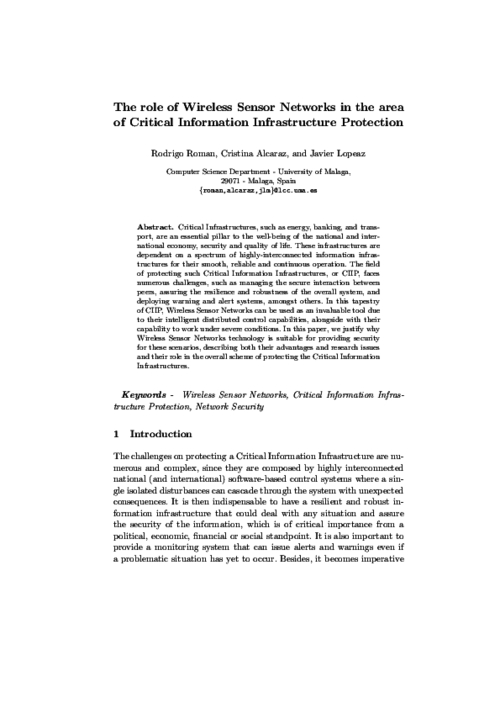
-
"On the Protection and Technologies of Critical Information Infrastructures.",
On Foundations of Security Analysis and Design IV, FOSAD 2006/2007, Springer, LNCS 4677, pp. 160-182, 2007. DOI
 More..
More..Abstract
Critical Infrastructures are complex and highly interconnected systems that are crucial for the well-being of the society. Any type of failure can cause significant damage, affecting one or more sectors due to their inherent interdependency. Not only the infrastructures are critical, but also the information infrastructures that manage, control and supervise them. Due to the seriousness of the consequences, the protection of these critical (information) infrastructures must have the highest priority. It is the purpose of this book chapter to review and discuss about these infrastructures, to explain their elements, and to highlight their research and development issues. This chapter will also discuss the role of Wireless Sensor Network (WSN) technology in the protection of these infrastructures.
